
10
Jan
(Beyond Pesticides, January 10, 2017) Exposure to neonicotinoid (neonic) insecticides leads to a decrease in pollination frequency and fewer social interactions in bumblebees, according to research published by scientists from Harvard University and University of California, Davis. The study, released last year but presented this week at the Society for Integrative and Comparative Biology’s annual meeting, underscores the need for regulators and policy makers to eliminate use of these chemicals, not only to protect honey bees, but also wild pollinators like the bumblebee.
While worker bumblebees (Bombus impatiens) divide their tasks within the colony in a similar manner to honey bees, their nests appear quite different than their more structured cousins. “Bumblebee nests are not the organized, beautiful geometry of the honeybee,” said James Crall, PhD candidate in Harvard’s Department of Organismic and Evolutionary Biology. Instead, “They’re more a hodge-podge of food and larvae in a pile in the middle of the nest space.”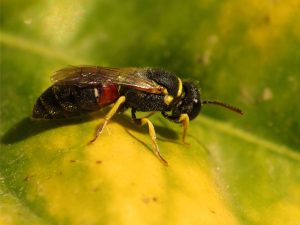
For their study, researchers placed four bumblebee colonies in a mesh enclosed area, tagged each bee, and observed them foraging on tomato flowers grown in a pollinator-excluding greenhouse (to ensure bees had freshly-opened flowers for pollination each day). After observing normal behavior, bees within each colony were then randomly assigned to ingest increasing levels of the neonic imidacloprid (0, 0.0515, 0.515, or 5.15Â ng of imidacloprid, respectively). Results show that workers exposed to imidacloprid tend to move toward the outside edge of the nest and spend less time caring for their brood (young).
Pollination by individual workers is also significantly affected by imidacloprid exposure, with pollinating worker bees less likely to resume foraging after being exposed. The morphology of the tomato flower makes it nearly impossible to be successfully pollinated by honey bees. Instead, bumblebees (and certain other wild pollinators) “sonicate,” or buzz tomato plants by producing a vibration that shakes loose the plant’s pollen. But researchers found that even at low and modest doses (0.515, or 5.15 ng) neonic exposure makes pollination significantly less likely.
This study is simply the latest in a robust body of research showing harm to wild and native pollinators from neonicotinoid exposure. A study presented last year at the British Ecological Society’s annual meeting determined that the neonic thiamethoxam makes it more difficult for bumblebees to learn how to sonicate. Compared to a control group, neonic treated bumblebees failed to produce a strong vibration, leading to less pollen collection. The results of these collective studies help confirm research from Scottish investigators published 2015 showing that neonics harm the brain cells of bumblebees.
Scientists have shown that the effects of neonics go beyond the direct impact on pollination skills to the size of neonic-exposed bumblebee colonies. Colonies treated with the neonic clothianidin recorded fewer workers, drones, and reproductive female bees compared to colonies without exposure.
Despite the fact that wild pollinators enhance fruit set in agricultural fields and pollinate more effectively than honey bees, given the widespread and continued use of neonics, it is little wonder why studies have noted that wild pollinators are in decline. In the United Kingdom alone, researchers from the Centre for Ecology and Hydrology have linked the use of neonics to the loss of half the country’s wild pollinators.
While this data is critically important in understanding the extent of the current crisis, it is imperative that advocates use this information to press for change. At the federal level, as the Fish and Wildlife Service has eliminated neonic use at national wildlife refuges out of precaution, the U.S. Environmental Protection Agency (EPA) represents a stark contrast, doing little to address the impact of these chemicals on undervalued and unprotected wild pollinators. When EPA reviewed the neonic imidacloprid for its impacts to pollinators early last year, the agency only analyzed honey bee health, despite the thousands of other unique, and potentially endangered wild pollinators that are likely to come into contact with these poisons.
Though disquieting for researchers and advocates alike, the fact is that EPA’s decisions are made with considerations beyond the science at hand. In determining whether to restrict a chemical, public input weighs heavily. For those who support pollinator health and want to influence federal decisions on this issue, the best way to increase the pressure is to get active in your local community. Work to pass pesticide policies that protect both honey bees and wild pollinators, as numerous communities (see yellow boxes) have done. For assistance, contact Beyond Pesticides at [email protected].
More information on protecting wild pollinators where they forage can be found on Beyond Pesticides’ Managing Landscapes with Pollinators in Mind webpage. Also stay tuned to Beyond Pesticides’ new monthly series PolliNATION, which aims to celebrate our less known, but critically important wild pollinators.
Source: Phys.org
All unattributed positions and opinions in this piece are those of Beyond Pesticides.
Posted in Agriculture, Alternatives/Organics, Biodiversity, Chemicals, Environmental Protection Agency (EPA), Hydroponics, Imidacloprid, Increased Vulnerability to Diseases from Chemical Exposure, National Politics, Pesticide Drift, Pesticide Regulation, Pesticide Residues, Pollinators by: Beyond Pesticides
1 Comment
09
Jan
(Beyond Pesticides, January 9, 2017) After the U.S. Environmental Protection Agency (EPA) released its recent human health risk assessment for the organophosphate insecticide (OP) tetrachlorvinphos (TCVP) on December 21, 2016, the agency announced it was allowing the continued use of the neurotoxic chemical to which children are widely exposed through pets’ flea collars and other flea treatments. According to EPA, ” TCVP is used as a direct animal treatment to livestock (i.e., cattle, horses, poultry and swine) and their premises, in kennels, outdoors as a perimeter treatment, and as a flea treatment [including flea collars] on cats and dogs.”
In its announcement on January 4, 2017, EPA states, “We advise consumers to take certain precautions when handling TCVP products in residential areas. These precautions are listed on TCVP product labels, including: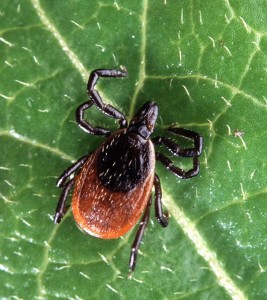
- not allowing children to play with TCVP pet collar products,
- keeping TCVP spray and powder products out of reach of children, and
- washing hands thoroughly with soap and water after handling.”
Advocates have raised concerns related to similar decisions on flea collars in the past in which EPA has issued warnings to mitigate risks, despite its inability to ensure children’s safety. Children typically come into close contact with pets and their flea collars that cannot be controlled by the type of warning EPA is issuing. Additionally, there is ongoing concern that low level volatility in the home from treated pets in close proximity to family members represents an unacceptable hazard to a neurotoxic pesticide.
TCVP, like other organophosphates, works by inhibiting the enzyme acetylcholinterase. The inhibition leads to the accumulation of acetylcholine and ultimately toxicity to the central and peripheral nervous system. Organophosphates are nerve poisons that cause numbness, tremors, nausea, incoordination, blurred vision, difficulty breathing or respiratory depression, and slow heartbeat. TCVP, while most commonly found in fleas and tick control collars for pets, is used orally and dermally on livestock for flea and tick control. It is formulated in a variety of ways, including dusts, powders, and liquid sprays. Aside from coming into contact with a pet wearing a flea or tick collar, people can be exposed to TCVP via food and water and, as a result of this livestock use, EPA has determined that there is dietary exposure to people. There are also numerous occupational risks of exposure, affecting applicators, veterinarians, pet groomers, and livestock caretakers.
In its review, EPA acknowledges that it does not have all the all the data it needs to assess the affect of exposure to the pesticide on children and therefore has applied an additional 10x margin of safety factor. Advocates have disputed the decision to allow children’s exposure when the data on TCVP’s effects is not complete. EPA said, “For TCVP, as for other OPs, the FQPA safety factor (SF) of 10X has been retained for infants, children, youths, and women of childbearing age for all exposure scenarios due to uncertainty in the human dose-response relationship for neurodevelopmental effects.”This approach to regulating pesticides rejects the precautionary principle, which eliminates use until complete data is available.
The agency review respondt to a 2009 petition filed by Natural Resource Defense Council. The assessment was finalized by the Health Effects Division (HED) of the EPA as requested by the Office of Pesticide Programs Pesticides Re-evaluation Division. TCVP is a common active ingredient in tick and flea control pet collars, and is part of a class of insecticides called organophosphates, which attack the nervous system.
The previous human health risk assessment was completed in December 2015. The finalized risk assessment reflects a few updates since the 2015 risk assessment. According to EPA, the finalized risk assessment identified risks to people that exceed EPA’s level of concern. These groups include adults and children in residential settings who are exposed to dusts/powder products and pet collars, and workers applying TCVP. One of the more important points of the risk assessment included a reduction of the oral toxicological point of departure (POD) from 8.0 mg/kg/day to 2.8 mg/kg/day. More simply put, researchers identified that, in experiments with rats, observed negative effects from exposure to TCVP occurred at lower doses than previously recorded.
In 2015, the California Environmental Protection Agency’s Office of Environmental Health Hazard Assessment (OEHHA) announced that it intended to list TCVP and two other organophosphate insecticides as cancer-causing chemicals under California’s  Safe Drinking Water and Toxic Enforcement Act of 1986 (Proposition 65). If a chemical is listed under Proposition 65, businesses that use this chemical are required by law to inform consumers about potential exposure.
Children face unique hazards from pesticide exposure. They take in more pesticides relative to their body weight than adults in the food they eat and air they breathe. Their developing organ systems often make them more sensitive to toxic exposure. The probability of an effect such as cancer, which requires a period of time to develop after exposure, is enhanced if exposure occurs early in life.
The National Academy of Sciences reports that children are more susceptible to chemicals than adults and estimates that 50% of lifetime pesticide exposure occurs during the first five years of life. The World Health Organization (WHO) cites that over 30% of the global burden of disease in children can be attributed to environmental factors, including pesticides.
While it is important to keep pets and home free of fleas and ticks, Beyond Pesticides recommends talking to your veterinarian about treatment options and asking questions about poisoning incidents associated with any product she or he recommends. Aside from pesticides, pet owners should vacuum daily during flea season with a strong vacuum cleaner, changing the bag often; groom pets with a flea comb daily, using soapy water to dunk and clean the comb between strokes; bathe pets frequently with soap and water; and, restrict pets to a single bed and wash bedding frequently to kill larvae. If you choose to use a flea and tick product on your pet, have it applied by your veterinarian and monitor pets for any signs of an adverse reaction after application. For more information on protecting your pet, read Beyond Pesticides factsheet, Pesticides and Pets: What you should know to keep your pets safe.Also see Beyond Pesticides’ factsheets, Least-Toxic Control of Fleas and Least-Toxic Control of Ticks.
Source: Final Occupational and Residential Exposure Assessment for Registration Review
All unattributed positions and opinions in this piece are those of Beyond Pesticides.
Posted in Announcements, Chemicals, Children/Schools, contamination, Disease/Health Effects, Environmental Protection Agency (EPA), Nervous System Effects, organophosphate, Pesticide Regulation, Pesticide Residues, Pets by: Beyond Pesticides
No Comments
06
Jan
(Beyond Pesticides, January 6, 2017) When it comes to pollination, bees tend to get all of the buzz. While they are crucial to pollinating many crops, it is important to note that bees aren’t the only pollinators working hard to provide the ecosystem services we rely on to support our food system. In fact, one out of every three bites of food we take is made possible by pollinators. In order to raise awareness for the unsung pollinator heroes all around us, Beyond Pesticides created the Polli-NATION Campaign, which highlights the important work of a relatively unknown pollinator each month. With it, we will raise public awareness about these pollinators, their contribution to plant health and productivity and the preservation of natural resources, and the threats they face in their daily lives, including toxic pesticides and habitat loss.
Polli-NATION members include species like butterflies, wasps, flies, beetles, birds, bats, and more. By taking the time to read about our featured Polli-NATION pollinator, you will not only learn about the many diverse species we call pollinators, but also discover what you can do in your daily life to help ensure their survival.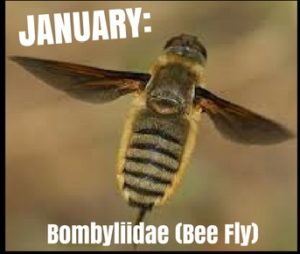
Our pollinator of the month is the bee fly! Over 5,000 species of Bombyliidae (Bee Flies), a large family within the order Diptera, can be found across the globe. While few of these species have been researched in great depth, they all have similarities that tie them to their classification. The vast majority of Bee Fly species have larvae that are parasitoids, and all adults feed on a diet of pollen and/or nectar, making them important pollinators.
Range
Bee Flies have been discovered on every continent but Antarctica. The most diverse group of species can be found in semi-arid and arid (desert) environments such as western North America, southern parts of South America, along the equatorial lines of Africa, and the mid latitudes of Eurasia.
Diet and Pollination
Most Bee Flies in their larval stage are parasitoids to the larvae of other soil-inhabiting insects. As opposed to parasites, which usually live off their host, but do not always cause death, parasitoids like the Bee Fly always kill their host. According to the World Catalog of Bee Flies, larvae of some Bombyliidae species prey on major agricultural pests, such as locusts, grasshoppers, armyworms, slugs, and caterpillars. However, select species have been found to be parasitoids of other pollinators like solitary bumblebees. And a small number species of Bee Fly larvae simply prey on insect eggs.
Most adult Bee Flies, once fully mature, feed on nectar from a variety of native flowering plants. Females are required to consume pollen in order to provide the protein and nourishment necessary for the development of eggs and reproduction. Bee Flies are thought to be responsible for what are called “pollination syndromes,” meaning many native flowering plants coevolved and adapted with Bee Flies.
Physiology
Adult Bee Flies are adapted for a pollen and nectar diet, and their physiology shows it. They have small bodies which range in length from 1mm to 2.5cm, depending on the species. Their wingspan can be as small as 1.5mm, though larger species can have a span of more than 60mm. Many species utilize biomimicry, in terms of their coloration, often resembling bees (hence their common name as the Bee Fly) or wasps. This offers them protection, as their predators assume that they have the temperament of a more aggressive species. Nonetheless, some species simply have a solid coloration of grey or rusted brown. Bee Flies’ wings appear swept back when at rest, and their legs are generally long and skinny compared to their body, with bristles at the ends. Many Bee flies are equipped with a very long proboscis (tubes that enable them to lap up nectar) that allows them to collect nectar from flowers with long narrow floral tubes. The Bee Flies’ proboscis is fixed, and cannot be retracted, giving it a tusk-like resemblance.
Ecological Role
Bee flies play an important ecological role as pollinators, particularly for flowering desert plants in the U.S. Southwest. Although the Bombyliidae family is understudied, the World Catalog of Bee Flies notes that because many flowering plants require Bee Fly pollination in order to propagate, some endangered plant species are likely reliant on the conservation of certain bee fly species. In addition to providing valuable pollinator services as adults, as noted earlier, Bee Fly larvae can play an important role in pest control. In addition to controlling agricultural pests like slugs and locusts, some species prey on the tste fly, which are infamous for their ability to transmit human diseases like trypanosomiasis, or sleeping sickness.
Threats to Existence
A literature review by the Bureau of Land Management (BLM) notes, “At any single locality a population of bee flies may be considered to be endangered, but throughout the desert areas they may not appear to be so because of their apparent wide distribution.” Because their interaction between specific flowers and certain Bee Fly species is so closely intertwined, habitat loss represents a significant threat to the Bombyliidae family. BLM’s literature review provides an example of the importance of maintaining habitat in the Algodones Dunes near Imperial County, CA. Areas open to recreational vehicles like ATVs resulted in the loss of a majority of flowering plants. While Bee Fly numbers in these areas became locally extinct, areas adjacent to the recreational area maintained their population numbers.
Pesticides, particularly persistent, systemic neonicotonoid insecticides, also represent a serious threat to many Bombyliidae species. Because many species feed on agricultural pests, they are more likely to be exposed to pesticides in these areas. Although the impacts of neonicotinoids and other pesticides on wild pollinator species are understudied when compared to investigations on honey bees, research that has been performed is cause for concern.
How to Protect the Species
There are a few simple ways to protect Bee Fly populations. Providing habitat by planting native flowers is an important first step for Bombyliidae conservation. Providing native habitat is especially important for individuals in arid or semi-arid regions of the U.S. Southwest, and these flowers are relatively easy to maintain as they do not require a lot of water and there is plentiful sun.
It is also critical to avoid planting any seeds or flowers that may be coated in pollinator-toxic neonicotinoids, as these chemicals can undermine your intent to provide forage and habitat for wild pollinators. See Beyond Pesticides’ Pollinator Friendly Seed and Nursery Directory as a starting place. And for more information, see the webpage on Managing Landscapes with Pollinators in Mind. You can also get active in your community to protect these pollinators by holding native planting days in the spring, and advocating for changes to community pesticide policies. Lastly, by buying organic, you can support an agricultural system that eschews the use of toxic pesticides like neonicotinoids that harm native pollinators.
For more information on how you can get involved in pollinator conservation throughout the nation, see Beyond Pesticides BEE Protective webpage.
For citations on this information, see our Polli-NATION webpage.
Posted in Agriculture, Announcements, Chemicals, Grasshoppers, Habitat Protection, neonicotinoids, Pesticide Residues, Pests, Pollinators by: Beyond Pesticides
No Comments
05
Jan
(Beyond Pesticides, January 5, 2017) Winegrowers in the Texas High Plains region are concerned that approval of new herbicides by the U.S. Environmental Protection Agency (EPA) will devastate their profitable industry due to chemical damage from pesticide drift. Wine producers in this region of Texas have witnessed chemical damage to their vineyards that they blame on the toxic herbicides, dicamba and 2,4-D, used on cereal crops and pastures on surrounding agricultural land. A new herbicide formulation containing dicamba, XtendiMax with VaporGrip Technology, was approved by EPA, and the agency has recently proposed to register and expand the use of Enlist Duo, a herbicide that contains 2,4-D. EPA’s final decision on registration of Enlist Duo is expected in early 2017.
According to Paul Bonarrigo, owner of Messina Hof Winery in Texas, the “approval of these formulations will wind up affecting every vineyard up there.” This will have ramifications across Texas, as the wine industry contributed $1.88 billion to the state’s economy in 2013. Advocates say that the new herbicide formulations present unreasonable adverse risks to humans and the environment in addition to harming the livelihood of farmers.
Following on these concerns, Garrett Irwin, owner of Cerro Santo vineyard, stated,“If we get the levels of damage that I’m afraid we’ll get, vineyards will not be able to recover or produce grapes at any sustainable level, and we’re just going to have to go away.”
The recently registered formulation of dicamba, XtendiMax with VaporGrip Technology, developed by Monsanto, is used in the production of genetically engineered (GE) cotton and soybean crops. Dicamba has been linked to kidney and liver damage, neurotoxicity, and developmental impacts, and has been at the center of many recent controversies. In August, farmers in Missouri, Arkansas, and Tennessee confronted widespread crop damage and braced for lower yields as a result of agrichemical giant Monsanto’s botched roll-out of GE soybean and cotton crops. The company, whose herbicide glyphosate (Roundup) is failing to control weeds in its glyphosate-tolerant crops throughout the U.S. and across the globe, developed a new line of soybean and cotton with traits that make it tolerate applications of dicamba. In October, EPA launched a criminal investigation at several locations in Missouri into the illegal spraying of dicamba, which resulted in drift and off-site damages.
Developed by Dow AgroSciences (Dow), Enlist Duo is an herbicide that incorporates a mix of glyphosate and a new formulation of 2,4-D, intended for use on GE Enlist-Duo-tolerant corn and soybean crops. In addition to Enlist Duo’s widespread use on corn and soybeans, EPA has proposed extending its use on GE-cotton and expanding its approval to 19 additional states. This herbicide has been marketed as a “solution” for the control of glyphosate-resistant weeds brought on by the widespread use of the chemical on Roundup Ready crops over the last decade that has led to super-weeds.
But even if farmers using these toxic herbicides follow the label instructions, there is high likelihood of drift from changing wind direction or speed, and temperature or humidity fluctuations. Claims of Enlist Duo’s lower volatility has limited application to field realities, given different environmental and application variables that play a part in whether the chemical will remain on site or travel off site. And, according to Garrett Irwin, “Complaints about drift damage from off-label spraying filed with the department are fruitless. The department usually responds to complaints by sending a field expert to assess the damage and interview neighbors about the herbicides they use, but neighbors who unlawfully spray are almost never investigated.”
The problem facing Texan winegrowers is not unique to grapes. Pesticide drift is an inevitable problem of pesticide application, and drift and subsequent crop injury to broadleaf crops has been a frequent problem. Abnormal leaf growth, floral development, reduced yield, and reduced quality have all been observed from dicamba drift in particular. A study published by Pennsylvania State scientists in late 2015 found dicamba drift was “frequently responsible for sublethal, off-target damage” to plants and insects. Historically, to mitigate against potential risks from pesticide drift, EPA has required buffer zones and application restrictions. However, these have not been sufficient to alleviate off-site crop damage and environmental contamination. Additionally, as demonstrated with these incidents, there are challenges with pesticide product label compliance and enforcement.
Beyond Pesticides has long advocated a regulatory approach that prohibits hazardous chemical use and requires alternative assessments to identify less toxic practices and products under the unreasonable adverse effects clause of the Federal Insecticide, Fungicide and Rodenticide Act (FIFRA). Farm, beekeeper, and environmental groups, including Beyond Pesticides, have urged EPA to follow in the steps of countries like Canada and the European Union by following the precautionary principle, which generally approves products after they have been assessed for harm, not before. Beyond Pesticides suggests an approach that rejects uses and exposures deemed acceptable under risk assessment calculations, and instead focuses on safer alternatives that are proven effective, such as organic agriculture, which prohibits the use of toxic chemicals. By strengthening on-farm resources, such as soil fertility, pasture and biodiversity, organic farmers can minimize and even avoid the production challenges that most genetically engineered organisms have been falsely-marketed as solving.
Sources: Texas Tribune, Rivard Report
All unattributed positions and opinions in this piece are those of Beyond Pesticides.
Posted in 2,4-D, Agriculture, Alternatives/Organics, Announcements, Chemicals, contamination, Contamination, Corporations, Dicamba, Disease/Health Effects, Dow Chemical, Environmental Protection Agency (EPA), Genetic Engineering, Glyphosate, Kidney failure, Liver failure, Monsanto, Pesticide Drift, Pesticide Residues, Resistance, State/Local, Texas by: Beyond Pesticides
No Comments
04
Jan
(Beyond Pesticides, January 4, 2017) The New Year saw its first pesticide-related tragedy yesterday when four children, ranging in age from 7-17, died from a toxic pesticide treatment on their house in Amarillo, Texas. The pesticide at issue, aluminum phosphide, was illegally applied under a mobile home where at least ten people were living. The chemical, classified by the U.S. Environmental Protection Agency (EPA) as a restricted use pesticide (RUP), is restricted for use by certified applicators (and those under their supervision) and it is a violation to use it within 100 feet of residential structures. CNN reports that a family member used water to try and wash away the pesticide after it was applied, and the combination of water and aluminum phosphide increased the release of toxic phosphine gas.
The incident demonstrates the deficiency of managing risks of highly toxic chemicals by labeling them “restricted use.” It has been Beyond Pesticides’ position that chemicals with aluminum phosphide’s level of toxicity should not be available on the market, even with restrictions. In making regulatory determinations on pesticide allowances, advocates have urged EPA to calculate the reality of misuse and accidents, instead of assuming 100% compliance with product label instructions. With this approach, the agency would not register pesticides as highly toxic as aluminum phosphide. Similarly, Beyond Pesticides has argued that the registration of chemicals like aluminum phosphide is “unreasonable” under the Federal Insecticide, Fungicide and Rodenticide Act (FIFRA), given the availability of alternative methods and products for rodent control.
FIFRA allows EPA to register a pesticide that “when applied in accordance with its directions for use, warnings and cautions and for the uses for which it is registered, or for one or more of such uses, or in accordance with a widespread and commonly recognized practice, may generally cause, without additional regulatory restrictions, unreasonable adverse effects on the environment” –if it classifies the pesticide as “restricted use.” RUPs may be legally used only by certified applicators or someone acting under the direct supervision of a certified applicator. Although certified commercial applicators must demonstrate proficiency, certified private applicators may only be required to attend training.
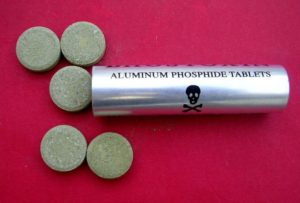
First responders arrived at the home after receiving a call that many members of the family had fallen ill, but by the time they arrived it was too late for the children, as one was dead at the scene and the three others died shortly after being rushed to the hospital. Children generally are more susceptible to chemical exposure than adults because they take in more pesticides relative to their body weight and have developing organ systems that are more vulnerable and less able to detoxify toxic chemicals. In 2010, two young girls aged 4 and 18 months died in Utah after being exposed to the same poisonous gas when aluminum phosphide was used on their lawn to treat a rat infestation. For more information on how pesticide exposure can affect children more acutely than adults, see our fact sheet Children and Pesticides Don’t Mix. The incident is currently being reported as an accidental poisoning.
Aluminum phosphide and other phosphide fumigants are known to be highly acutely toxic when ingested or inhaled, and aluminum phosphide is listed by the Environmental Protection Agency (EPA) in the Toxicity Category I, which is the highest and most toxic category. Symptoms of mild to moderate acute exposure include nausea, abdominal pain, tightness in chest, excitement, restlessness, agitation and chills. Symptoms of more severe exposure include, diarrhea, cyanosis, difficulty breathing, pulmonary edema, respiratory failure, tachycardia (rapid pulse) and hypotension (low blood pressure), dizziness and/or death. Aluminum and magnesium phosphide fumigants are used primarily to control insects in stored grain and other agricultural commodities. They also are used to control burrowing rodents in outdoor agricultural and other non-domestic areas. The fumigants are restricted to use by specially trained pesticide applicators.
In recent years, EPA has taken steps to try and address the clearly inadequate regulations regarding phosphide fumigants, but the recent death of these four children indicates that they need to revisit the current rules. In 2010, EPA imposed new restrictions on aluminum and magnesium phosphide products in an attempt to better protect people, especially children, from dangerous exposures. The restrictions prohibit, by requiring it be included on product labels, all uses of the products around residential areas and increase buffer zones for treatment around non-residential buildings that could be occupied by people or animals from 15 feet to 100 feet. However, the latest incident raises concerns about the adequacy of the pesticide’s label restrictions to actually protect human lives, and the enforceability of the rules when violations occur.
Beyond Pesticides advocates defined integrated pest management (IPM) for structural pest prevention and the utilization of non-toxic methods to manage rodents. If defined clearly, IPM eliminates toxic pesticide use and exposure to any toxic products. Sanitation, structural repairs, mechanical and biological control, pest population monitoring, and occupant education on eliminating pest conducive conditions are some IPM methods that prevent or control rodents and insects.
EPA recognizes that the use of toxic chemicals to control rodents is itself not effective rodent management. IPM practices are recommended by EPA for rodent control in and around households. EPA advises that effective rodent control requires sanitation, rodent proofing, and removal of rodent harborage, habitat modification to make an area less attractive to rodents, and discourage new populations from recolonizing the area. Non-chemical devices such as snap traps and other trapping systems are also affordable and quite effective as a method for rodent control.
However, while EPA recognizes that IPM practices are safe and effective methods for controlling rodents, the dependency on the rodenticides as a means of control continues. Given that EPA acknowledges that effective rodent management will not be achieved without the adoption of safer IPM techniques, it is imperative that these practices are promoted to the consumer so that efforts can work toward the elimination of public and environmental exposures to low levels of toxic rodenticides. To do this, rodenticide labels must require the users to establish IPM practices and only allow the introduction of poisons as a part of this approach as a last resort.
For more information on rodenticides and the alternatives to managing rodents, see Beyond Pesticides fact sheet “Rodents Teach Lesson of Failed Chemical Controls: City officials gather to learn new approaches to rodent management less dependent on chemicals, more focused on habitat reduction.” For least toxic control of mice and other pests visit Beyond Pesticides’ alternatives page.
Source: CNN
All unattributed positions are that of Beyond Pesticides.
Posted in Alternatives/Organics, aluminum phosphide, Announcements, Chemicals, Disease/Health Effects, Environmental Protection Agency (EPA), Integrated and Organic Pest Management, Label Claims, Pesticide Regulation, Pests, Rodenticide, Rodents by: Beyond Pesticides
1 Comment
03
Jan
(Beyond Pesticides, January 3, 2017) A study published in December 2016 in Environmental Contamination and Toxicology, entitled The Effect of Atrazine on Louisiana Gulf Coast Estuarine Phytoplankton, finds that phytoplankton in estuaries in close proximity to agricultural operations are less productive than phytoplankton in an uncontaminated environment. The study examines three different estuaries of the Mississippi river in Louisiana and also evaluates microcosms with different concentrations of atrazine. Phytoplankton, incredibly important to estuary ecosystems and aquatic life, are an integral part of the aquatic food web and ultimately critical to the wild seafood market. As photosynthetic microorganisms, phytoplankton harness the sun’s energy for metabolism and create as a byproduct of photosynthesis dissolved oxygen, which oxygen-breathing sea life require.
For the study, the researchers created microcosms, or large containers that are able to closely mimic ecosystems, so that they can observe the effects of independent variables. On average, phytoplankton in the microcosms are less productive at producing chlorophyll a in the presence of atrazine. The microcosm study design is important because it is difficult to separate and measure the effects of chemicals like atrazine in the environment, given the range of potential causes of phytoplankton decline. A variety of factors, like freshwater discharge rates, precipitation, and seasonal changes, make it difficult to adequately measure the variables that affect phytoplankton populations. The researchers call for a long-term study to gain a greater understanding of the scope of the atrazine contamination problem. The ongoing concern of the researchers is driven by the fact that the herbicidal properties of atrazine could have similar effects on phytoplankton as it does on terrestrial plants, since they both rely on photosynthesis for metabolism.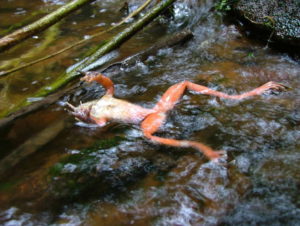
Atrazine is the second-most widely used pesticide in the United States, with over 73 million pounds applied to agricultural fields each year. Once applied to farms, precipitation and other factors cause the chemical to runoff into surrounding streams and groundwater aquifers. In 2012, water utilities settled a class action lawsuit against the manufacturer of atrazine, Syngenta, to clean up atrazine contamination of its treated water.
Even at levels established as “safe” or acceptable by EPA drinking water standards, atrazine is linked to endocrine-disrupting effects. EPA is not adequately assessing the effects of atrazine by using high dose testing models, which are not appropriate for hormonally-active substances that often show effects at minute doses of endocrine disruptors. Studies by Tyrone Hayes, Ph.D., University of California, Berkeley,  and others have shown that concentrations as little as 0.1ppb impact hormone function in organisms and turns tadpoles into hermaphrodites — organisms  with both male and female sexual characteristics. Research also finds that atrazine interferes with mammary gland development in the breast of mammals and is linked to certain birth defects  like gastroschisis and choanal atresia, which are significantly increased for pregnant women with high levels of atrazine exposure in agricultural areas and from urban streams. The European Union and many countries have banned atrazine, however EPA continues to put U.S. citizens and the environment in harm’s way, allowing nonstop use of this toxic chemical.
in April 2016, EPA released a draft ecological risk assessmen that finds atrazine poses unacceptable risks  to fish, amphibians, aquatic invertebrates, and even birds, reptiles and mammals. The assessments evaluated risks to animals and plants, including amphibians, birds, mammals, fish, reptiles, aquatic invertebrates, aquatic plant communities, and terrestrial plants. EPA concludes, “aquatic plant communities are impacted in many areas where atrazine use is heaviest, and there is potential chronic risks to fish, amphibians, and aquatic invertebrate in these same locations. In the terrestrial environment, there are risk concerns for mammals, birds, reptiles, plants and plant communities across the country for many of the atrazine uses.” Levels of concerns were exceeded by as much as 200-fold for some organisms!
The phytoplankton study is another reminder that atrazine is proven to have an effect on aquatic ecosystems. In July 2016, California’s Office of Environmental Health Hazard Assessment (OEHHA) announced that atrazine, its chemical cousins propazine and simazine, and its breakdown triazine compounds would be added to the list of chemicals known to the state to cause reproductive toxicity for purposes of the state’s Proposition 65.
The evidence is clear. Atrazine harms wildlife, persists in soils, and moves easily through waterways. Take Action: Sign the petition to urge EPA to end the use of atrazine. In order to protect human and ecological health, the agency should take immediate action to eliminate this chemical from our environment!
Source: The Effect of Atrazine of Effect of atrazine on Louisiana Gulf Coast Estuarine Phytoplankton
Posted in Agriculture, Alternatives/Organics, Announcements, Atrazine, Chemicals, Contamination, Environmental Protection Agency (EPA), Lawns/Landscapes, Louisiana, Pesticide Regulation, Pesticide Residues, Pollinators, State/Local, Water Regulation, Wildlife/Endangered Sp. by: Beyond Pesticides
No Comments
24
Dec
(Beyond Pesticides, December 24, 2016) Beyond Pesticides thanks our members and supporters for being a part of a critical movement to advance sustainable and organic land and building management in 2016. As our Daily News takes a holiday break, returning Tuesday, January 3, 2017, we hope you will join us in reflecting on the progress made this year, and the critical challenges that lie ahead.
The road ahead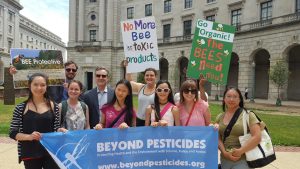
We are entering a period in our nation’s history with many serious concerns about the protection of public health and the environment. We have heard the President-elect’s rhetoric about the overreach of the Environmental Protection Agency (EPA), the burden of regulatory compliance, and the need to dismantle environmental programs. The nominee for EPA Administrator is on record as challenging science and the value of environmental protection.
In contrast, we have learned over the last several decades that protection of the environment contributes to a productive economy and healthier people. Beyond Pesticides’ databases track the scientific literature on pesticide hazards and alternatives, which clearly document the value of healthy ecosystems in providing ecosystem services that translate to reduced costs for farmers and land managers. Whether we’re talking about bees and other pollinators or predator insects, healthy ecosystems are critical to a sustainable future –our future.
This year’s election occurred in the midst of a societal shift to organic land management systems that protect our air, water, land, and reduce the threat of global climate change, while producing safe food in safe workplaces. Beyond Pesticides is a critical part of the progress we have made to create an over $40 billion organic sector, showing that the toxic chemicals that are deemed “acceptable” in our water, air, soil, food, and community parks and schoolyards are not necessary. With your support, we will build this wave of change from community to community, effecting an exponential shift away from toxic chemical use and a growing organic marketplace, regardless of a government controlled by corporate interests that seek to push toxic pesticide dependency. Our unique programs of community information assistance and hands-on training make the difference in the adoption of effective land and building management programs that eliminate pesticides.
Leading the way
Beyond Pesticides is leading the nation in stopping all hazardous pesticide use with on-the-ground practices. We were reminded of the importance of Beyond Pesticides’ program, which supports local action to protect community and environmental health, when U.S. EPA Administrator Gina McCarthy spoke to the Montgomery County (Maryland) Green Festival in April and told the packed auditorium that, “What happens in Montgomery County does not stay in Montgomery County.” She basically told the crowd that she couldn’t do anything unless it happened at the local level first. “Anything that manages to make the slow crawl to Capitol Hill has made it because it has had such fertile ground in our communities. . .Nothing makes its way there that’s a great idea, that’s really creative, and that has an opportunity to make a lasting impact unless it has been proven, time and time again, at the local level. . .then it makes its way up to the state when people are obnoxious and going to demand additional action, and so on and so on. So I have to congratulate you. . .” While she may not have been speaking directly to Takoma Park’s cosmetic lawn care chemical ban, followed by Montgomery County’s landmark ban, she could have been, along with the other local ordinances across the country that have been passed to protect health and the environment.
This year we’ve seen the continuation of local policies that illustrate misguided regressive state-level preemption laws. In South Portland, ME, the City Council passed the latest breakthrough pesticide ordinance, applying comprehensive restrictions on toxic chemical use to public and private property, a second for the state, following Ogunquit, ME’s award-winning policy. Washington D.C., a preemption-proof city because of its unique position in the federal system, also took bold steps in pesticide reform, updating its improperly implemented pesticide ordinance to protect children and waterways, and reflect the latest science and available organic materials.
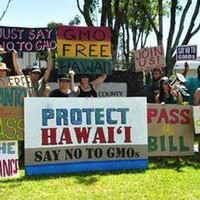
And communities in numerous states subject to preemption revealed the desire of localities to take action to protect their residents. In California, the cities of Irvine and Malibu passed organic focused pesticide reform ordinances. Following Minneapolis, MN’s organic focused resolution in 2015, its twin City of St. Paul, MN followed suit, echoing a request to the state to roll back state preemption policies that stop them from going further to restrict pesticides. As legal challenges in Hawaiian Counties and Montgomery County, MD show, the fight for local authority over toxic pesticide use continues.
As more schools and localities, like Villanova University, Antioch College, Macalester College, Milwaukie, OR, Howard County, MD and numerous Minnesota communities, continue to implement policy changes that protect pollinators from hazardous neonicotinoid insecticides, in 2016 we began to see states take part. In Maryland, the Pollinator Protection Act removes neonicotinoids from store shelves, and in Connecticut, An Act Concerning Pollinator Health passed unanimously through the legislature, enacting a range of common-sense protections for pollinators. As a result of coordinated advocacy efforts and over 15 local policies in Minnesota, Governor Dayton’s executive order made significant strides at addressing neonicotinoid use in agriculture.
Our work in Ogunquit and South Portland, Maine led to a teach-in at the Maine Organic Farming and Gardening Association (MOFGA) Country Fair in September to share with people across the state and northeast the experience of these communities and strategies for expanding the policy to other jurisdictions statewide. You can watch Part 1 of the session and Part 2 here. Nationwide, we continue to advance the pace of local policies and practices that embrace organic principles of land management.
In an effort to grow the pesticide reform movement, we launched the Map of U.S. Pesticide Reform Policies to show the widespread demand for pesticide restrictions and provide a tool, and accompanying blueprint, for advocates to use as they begin working in their community. We hope you’ll get in touch with us in the New Year to tell us about your efforts and how we can help bring them to fruition.
Bring on the goats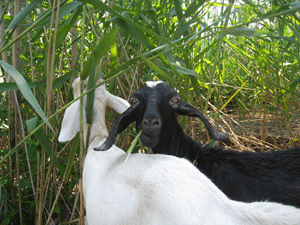
Goat grazing: is an effective tool for invasive and vegetation plant management and re-seeding; restores the land to life, heals the soil, and encourages ecosystem services to function; leads to plant resilience, which helps prevent future problems; and, increases soil organic matter, enhances soil health and moisture, decreases erosion, and supports desired plant species diversity with higher plant vigor. And, it’s a fire mitigation tool!
We brought a herd of 500 goats to conduct an intensive, managed goat grazing operation to manage invasive weeds on 300 acres of tribal lands of the Washoe Tribe of Nevada and California. We spoke before the Tribal Council about using goats for land management, healing the land, and stopping all herbicide use. This project reflects our deep commitment to show that the kind of change we advocate for as an organization is not only possible, but offers an approach that is more effective with long-term cost savings. That’s because we respect nature to reach a sustainable ecological balance. Our work shows how it is done and is a model for other land managers, Tribes, and communities across the nation. It can be used in urban areas, too!
Protecting organic integrity
We advance sustainable and organic practices with our food dollars. But, that requires that we hold the manufacturers and retailers accountable to the standards that are critical to protecting health and the environment. We published When Sustainable Is Less Than Organic, Is It Responsibly Grown?, which raises critical issues on alternative food labeling that undermines the organic label. Whole Foods Market’s Responsibly Grown rating system has been criticized as undermining the organic market by creating a set of standards based on criteria that do not utilize organic practices, values, and principles as its baseline. This allows products and commodities rated as “responsibly grown” to utilize a range of toxic inputs, including synthetic pesticides and fertilizers that are not permitted under organic standards as codified in the Organic Foods Production Act (OFPA). If the scheme was adding elements that have not yet been embraced by organic certification –such as farmworker protection, humane treatment and pasturing of animals, elevated restrictions of some controversial synthetic substances allowed in organic– then Responsibly Grown could have been envisioned as improving elements of sustainability within the organic framework. We continue to challenge the value of Integrated Pest Management (IPM) as a meaningful concept, given its lack of a definition and dependency on toxic chemicals that harm soil health. We sued General Mills for false and deceptive labeling on a product that carries the “natural” label, despite one of the major ingredients being treated with the herbicide glyphosate.
Making sure that organic complies with OFPA is a critical piece of what we as a network must focus on in the year ahead. To that end, we’ve set up our webpage Keeping Organic Strong –our way of engaging organic consumers and growers in ensuring the integrity of the certified organic label.
Bee Protective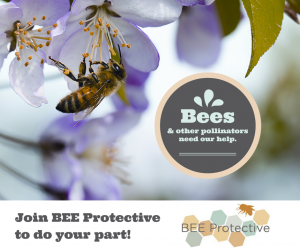
Pollinators continue to be an entry point for many people to engage in the larger issue of pesticide hazards and organic. Our challenge, through our pollinator campaign, called Bee Protective, is to keep the focus on neonicotinoids as symptomatic of a hazardous chemical-intensive food production and land management system and a failed regulatory system with inadequate protections. In this context, we seek to show that a chemical-by-chemical strategy does not move us off the pesticide treadmill, but on to the next family of chemicals with a new or continuing set of problems. We track the science on pesticides and pollinators and have one of the most thorough and up-to-date databases on the scientific literature, called What the Science Shows. We have developed a teaching curriculum on pollinators that we are providing to school systems and a pollinator starter kit. And, we launched a restaurant campaign to coincide with National Pollinator Week.
The National Forum- Mark your calendar
To help support local aCction, we’re holding our 35th national conference, Healthy Hives, Healthy Lives, Healthy Land: Ecological and Organic Strategies for Regeneration at the University of Minnesota, Minneapolis on April 28-29, 2017. Please join us. We maintain a uniquely informative video library of Forum speakers, including leading scientists, researchers, legislators, lawyers, farmers, and land managers. Check out the videos from the 2016 Forum, Cultivating Community and Environmental Health, at the University of Southern Maine in Portland, Maine.
Keeping regulatory deficiencies in the forefront
Our work to critique ongoing EPA regulatory decisions remains important as we seek to effect a shift to organic and ecological practices. Whether it is our comments on glyphosate or the systemic insecticide sulfoxafor, a neonicotinoid cousin, we point out the deficiencies with the agency’s analysis. This was the case with the use of the organophosphate Naled spraying for the threat of Zika virus transmission and EPA and Centers for Disease Control and Prevention (CDC) proclamations of the insecticide’s safety. We wrote to EPA to point out the deficiencies in its assessment of bystander exposure to Naled and put out a press release, EPA and CDC Mislead Local and State Officials and the Public on Safety of Mosquito Pesticides Used for Zika Virus. EPA wrote us back, acknowledging that it was seeking more information on the threat associated with Naled exposure through mosquito spray programs. With the large bee kill in South Carolina after a mosquito spraying, our piece, Mosquito Control and Pollinator Health: Protecting Pollinators in the Age of Zika and Other Emerging Mosquito Diseases, was timely.

The Food and Drug Administration (FDA) announcement that it was phasing out triclosan and other antimicrobials from liquid soaps gave us an opportunity to declare a regulatory victory and at the same time point out the deficiencies in allowing continued use in toothpaste and non-cosmetic products, such as socks, underwear and other textiles, hair brushes, cutting boards, computer keyboards, toys and other plastics (regulated by EPA).  Since 2004, Beyond Pesticides has worked to bring public attention to the dangers surrounding the proliferate use of triclosan in consumer goods. A petition submitted to both FDA and EPA by Beyond Pesticides in 2010 calls for the ban on triclosan based on the unnecessary health and environmental risks involved with its use, given the availability of safer alternatives. With the growing public awareness and the evolving market shift away from triclosan, the time is now for a complete federal ban on this unnecessary chemical. We argue that FDA should expand its ban on triclosan in hand soaps to all over-the-counter products, including toothpaste. And, it is critically important that EPA now step up to do the same for all the consumer product uses that it regulates. Beyond Pesticides’ work, joined by others, resulted in many manufacturers voluntarily removing triclosan from its products. Because of our work, by the time that FDA stepped in, there was little opposition to regulatory action.
Genetic Engineered Ingredient Labeling
With the growth of genetically engineered (GE) crops, we have learned that farmers are using more pesticides on herbicide-tolerant plants and seeing more weed resistance, which is forcing the development of new more toxic pesticide formulations. Genetic drift contaminates organic and the public is kept in the dark about which food products on the grocery store shelves contain GE ingredients. Meanwhile, despite losses on the federal and state front to require labeling, with public pressure companies started to respond –but is it misleading? Starting with Campbell’s Soup Company, companies announced that they will label for genetically engineered ingredients and then supported mandatory labeling requirements, leading to the passage of the Biotechnology Food Labeling and Uniformity Act (S.2621), which requires weak labeling, and preempts states from adopting different and stronger language, such as a warning.  Expect to see language on the companies’ website like, “The overwhelming weight of scientific evidence indicates that GMOs are safe and that foods derived from crops using genetically modified seeds are not nutritionally different from other foods.” Our goal is to make sure that GE ingredients and contamination does not invade organic production and products.
Breaking through Power
Our participation in the Ralph Nader event, Breaking through Power (held at Constitution Hall in Washington, DC in September), provided us with a forum to capture the importance of Beyond Pesticides’ mission and work in a 20-minute presentation. Introduced by Jim Hightower, we shared the history of the organization and its vision going forward. It is important to note that we were among the only, if not the only, organization of less than 20 organizations asked to speak that was not founded or supported at its founding by Mr. Nader, but certainly inspired by his advocacy in the public interest. In the years since Beyond Pesticides’ founding, Mr. Nader has spoken at Beyond Pesticides’ forums and supported our work.
Providing the tools for effective action
We maintain and enlarge Beyond Pesticides’ science and policy databases, which serve as an important counterweight to government agencies that ignore the independent peer-reviewed scientific literature. We have grown our Gateway on Pesticide Hazards and Safe Pest Management and Pesticide-Induced Diseases Database, which document the preponderance of science that justifies the policies and practices we advance. We conduct ongoing independent assessments of product ingredients and the supporting science to evaluate their impact on health and the environment. Together, this information supports, in real time, the need for elected officials to advance local policy in the face of federal standards that are not protective of health and the environment.
Happy Holidays and New Year
We will not accept a future with continued and rising toxic pesticide use that threatens our health and the sustainability of the planet. We will build on the successes of the past to meet the challenges of the future.
Thank you again for joining with us this year to sustain and grow these victories. We hope you’ll take some time this holiday season to celebrate these accomplishments, and come together with us next year, refreshed and ready for the serious challenges and new victories that lie ahead.
Best wishes for the Holiday Season and New Year!

Posted in Agriculture, Alternatives/Organics, Announcements, Antibacterial, Beneficials, Chemicals, Environmental Protection Agency (EPA), Increased Vulnerability to Diseases from Chemical Exposure, Label Claims, National Politics, Pesticide Regulation, Pollinators, Resistance, Take Action, Triclosan, Uncategorized by: Beyond Pesticides
No Comments
23
Dec
(Beyond Pesticides, December 23, 2016) The Environmental Agency (EPA) has finalized a proposal to ban 72 inert (or secret hazardous) ingredients from use in pesticide formulations following a long fight with environmentalists who, in 2006, asked that pesticide product labels disclose any of 371 inert ingredients that could be in products. While this finalization is a step in the right direction, ultimately the move is viewed by advocates as inadequate. The original petition, submitted by Northwest Coalition for Alternatives to Pesticides, along with Beyond Pesticides, Physicians for Social Responsibility, and nearly 20 other organizations, called on the agency to require disclosure of inerts. To put the announcement in perspective, EPA is acting on 72 inert ingredients that are no longer being used, such as turpentine oil, and nitrous oxide.
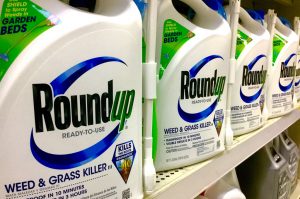
An inert ingredient is defined as any ingredient that is “not active,” or specifically targeted to kill a pest. According to a 2000 report produced by the New York State Attorney General, The Secret Ingredients in Pesticides: Reducing the Risk, 72 percent of pesticide products available to consumers contain over 95 percent inert ingredients and fewer than 10 percent of pesticide products list any inert ingredients on their labels. The report also found that more than 200 chemicals used as inert ingredients are hazardous pollutants in federal environmental statutes governing air and water quality, and, from a 1995 list of inert ingredients, 394 chemicals were listed as active ingredients in other pesticide products. For example, naphthalene is an inert ingredient in some products and listed as an active ingredient in others.
Some inert ingredients are even more toxic than the active ingredients. One of the most hazardous ingredients in the commonly used herbicide Roundup, POEA, is a surfactant that is classified as an inert and therefore not listed on the label. Researchers have found that POEA can kill human cells, particularly embryonic, placental and umbilical cord cells.
Despite these uncertainties and potential hazards, pesticide manufacturers are only required to list the active ingredients in a pesticide under the Federal Insecticide, Fungicide and Rodenticide Act (FIFRA). This leaves consumers and applicators unaware of the possible toxicity present in a vast majority of the pesticide formulations they are using unless the EPA Administrator determines that the chemical poses a public health threat.
Background
In September 2009, EPA first responded to two petitions, one led by the Northwest Centers for Alternatives to Pesticides in 2006 (mentioned above), and a second by 15 State Attorneys General that identified over 350 inert pesticide ingredients as hazardous. The petitioners asked EPA to require these inert ingredients be identified on the labels of products that include them in their formulations.
Then, on December 23, 2009, EPA took another promising step forward with an Advanced Notice of Proposed Rulemaking (ANPR), announcing its intention to seek public input on developing an inert ingredient disclosure rule. Putting forth two proposals, one to require listing all ingredients already identified as hazardous, and the other to require the listing of all ingredients on product labels. EPA then took no further action. As a result, some of the original petitioners filed an “undue delay” complaint against EPA in March 2014 for failing to complete rulemaking that would require pesticide manufacturers to disclose the inert ingredients on their pesticide product labels.
In response to that lawsuit, EPA retracted its previous ANPR and intention to move forward with rulemaking. Instead, EPA issued a letter to the original 2006 petitioners describing its intentions to seek non-rulemaking regulatory programs and voluntary disclosure standards, stating, “In sum, [EPA] believe[s] we have identified a more effective and timely way to achieve our common objective; but, because this approach would no longer pursue the rulemaking the EPA initiated via the [ANPR] seeking to mandate the disclosure of potentially hazardous inert ingredients on pesticide labels, as requested in the 2006 petitions, this amended response constitutes a denial of the petitions.”
EPA then used its change of position on issuing rulemaking and denial of the 2006 petition as a basis to have the undue delay lawsuit thrown out. This decision was challenged by environmental groups, but a federal judge in California handed down a decision in June 2016 agreeing with the EPA that it has no responsibility under federal pesticide law to complete rulemaking on the disclosure of hazardous ingredients in pesticide products.
Beyond Pesticides has long advocated a regulatory approach  that prohibits hazardous chemical use and requires alternative assessments to identify less toxic practices and products under the unreasonable adverse effects clause of FIFRA.  Beyond Pesticides was a co-plaintiff in the successful lawsuit Northwest Coalition for Alternatives to Pesticides et al. v. EPA (Civil Action No. 94-1100, 1996), in which the court ruled that “inert” ingredients should not be given blanket trade secret protection by EPA under the Freedom of Information Act (FOIA). In that case, the plaintiffs successfully argued that EPA must disclose inert ingredients since their secrecy from public disclosure served no proprietary interest for the chemical manufacturer. This same argument holds with respect to the product label.
The failure of EPA to require the disclosure of inert ingredients poses many problems for those trying to protect human health. Failure to disclose the ingredients not only prevents consumers and decision makers from making informed decisions and comparing hazards. Local and state governments also run into roadblocks in their efforts to protect citizens, as they cannot readily evaluate what is in the pesticides products (formulations) that they are spraying in their communities to make independent judgments on safety, putting their citizens at risk. Under the prevailing laws, it is EPA’s duty to assess these risks and disclose the necessary information, through pesticide labels, as to what harmful ingredients pesticides contain.
Environmental groups, including Beyond Pesticides, have consistently urged EPA to follow in the steps of countries like Canada and the European Union by following the precautionary principle, which generally approves products after they have been assessed for harm, not before. Beyond Pesticides suggests an approach that rejects uses and exposures deemed acceptable under risk assessment calculations, and instead focuses on safer alternatives that are proven effective, such as organic agriculture, which prohibits the use of toxic chemicals.
Source: EPA
All unattributed positions and opinions in this piece are those of Beyond Pesticides.
Posted in Agriculture, Alternatives/Organics, Announcements, Beneficials, Birth defects, Cancer, Chemicals, contamination, Corporations, Disease/Health Effects, Endocrine Disruption, Environmental Protection Agency (EPA), Monsanto, Pesticide Regulation, Pesticide Residues by: Beyond Pesticides
No Comments
22
Dec
(Beyond Pesticides, December 22, 2016) Legislation passed Monday in the District of Columbia stops the use of toxic pesticides near schools, child-occupied facilities, waterbody-contingent property, and public property. The Pesticide Education and Control Amendment Act (PECCA) of 2016 (Bill B21-0580), passed unanimously by the District Council, strengthens previous law to protect children and residents living in Washington DC from unnecessary pesticide exposure. The law places the District at the forefront with other communities around the country that are phasing out the use of toxic pesticides in building and land management.
The legislation, sponsored by Councilmember Mary Cheh, clarifies certain provisions of the original PECCA passed in 2012, which had not been implemented by the Department of Energy and Environment (DOEE) in accordance with the original spirit and intent of the law. The new law clarifies the department responsibility to prohibit all pesticide use near schools and waterbody-contingent properties, except a defined list of material allowed in organic land management. The law is intended to effect a transition to sustainable and cost-effective insect and weed management practices in the District.
Jay Feldman, Executive Director of Beyond Pesticides, said: “This law protects vulnerable populations, like children, from the dangers of unnecessary toxic pesticide use near schools and daycare centers, and prevents contamination of the environment and waterways on public and private land. We are pleased with the District’s decision to only permit products allowed for use in organic land management in these areas.”
Alan Cohen, President of BioLogical Pest Management Inc. said of the Council’s vote, “This is a huge step in the right direction for the District of Columbia. This law will help shift the industry in a way that still meets solves pest problems for consumers, but is far safer for humans, pets and the environment.”
Since the original law was adopted by the District in 2012, surrounding jurisdictions, including Takoma Park and Montgomery County, Maryland have banned toxic cosmetic pesticide use on public and private land within their jurisdictions. Pesticides move off the target site through drift and runoff, exposing non-target sites and people. Beyond Pesticides has mapped 115 communities in 21 U.S. states that have taken local action to protect their communities from the adverse effects of pesticides in the face of daily toxic chemical use –with a range tactics, from eliminating highly toxic chemicals to the adoption of organic practices. See more information on Map of U.S. Pesticide Reform Policies.
For information on organic land management, see Beyond Pesticides’ Lawns and Landscapes page and see Beyond Pesticides website for up-to-day information on pesticide hazards and alternatives.
See a copy of our press release here.
Contacts:
Beyond Pesticides, Jay Feldman, [email protected], 202-543-5450,
Annie D’Amato, [email protected], 202-543-5450.
All unattributed positions and opinions in this piece are those of Beyond Pesticides.
Posted in Alternatives/Organics, Announcements, Children/Schools, contamination, Environmental Protection Agency (EPA), Lawns/Landscapes, National Politics, Pesticide Drift, Pesticide Regulation, Pesticide Residues, State/Local, Washington D.C. by: Beyond Pesticides
No Comments
21
Dec
(Beyond Pesticides, December 21, 2016) A California Department of Pesticide Regulation (DPR) report of all pesticide related illnesses in the state in 2014 identifies 1,685 cases “potentially involving health effects from pesticide exposure,” combining exposures from agricultural and non-agricultural use. Of the 798 cases associated with non-agricultural use, 18% of them (146 cases) involved exposure in children under 18 years old. The exposure rates are alarming, and only strengthen efforts by local activists in counties like Tulare to protect children from pesticide exposure. According to the report, Tulare County has the highest number of reported illnesses related to pesticide exposure at 78, followed by Santa Cruz County with 67.
The report, Summary of Results from the California Pesticide Illness Surveillance Program 2014, provides a summary of illnesses identified by the Pesticide Illness Surveillance Program (PISP), a program under DPR. Of the 1,685 cases potentially involving health effects from pesticide exposure reported, DPR epidemiologists determined that 1,073 of those cases were “at least possibly associated” with pesticide exposure, representing a 5% decrease from 2013. However, even though the number of associated cases decreased in 2014, PISP did see a 14% rise in the number of associated episodes, defined as “an event in which a single source possibly, probably, or defin itely exposed one or more people (cases) to pesticides.” The number of cases associated with non-agricultural pesticide use also increased, up 16% from 2013 for a total of 798 cases. Of those 798 cases, 34% of them were defined as occupational, meaning that they occurred while the affected people were at work. PISP also looked in injuries to agricultural field workers, finding that 148 workers were affected by pesticide exposure in 25 different episodes, with 40 being the largest number of workers injured at one time.
itely exposed one or more people (cases) to pesticides.” The number of cases associated with non-agricultural pesticide use also increased, up 16% from 2013 for a total of 798 cases. Of those 798 cases, 34% of them were defined as occupational, meaning that they occurred while the affected people were at work. PISP also looked in injuries to agricultural field workers, finding that 148 workers were affected by pesticide exposure in 25 different episodes, with 40 being the largest number of workers injured at one time.
These increases are indicative of a need for increased protections from pesticide exposure for the people of California. Since this fall, public health advocates have been at odds with the state over a proposed rule intended to protect children by establishing buffer zones around schools. The proposed rule, Pesticide Use Near Schoolsites, proposes only limited restrictions for certain agricultural pesticide applications near schools and child day care facilities. It would require farmers to notify public schools and child day care facilities when “certain pesticide applications made for the production of an agricultural commodity near a school site are planned in the coming year and also a few days prior to the applications.” For pesticides applied via aircraft, airblast sprayer, sprinkler chemigation, and fumigation, there must be a minimum ¼ mile buffer around the school or child day care facility. Advocates say that while the move by CDPR is a step in the right direction, it is not rigorous enough, buffer zones are well below the one mile distance necessary, and does not adequately protect the most vulnerable populations from pesticide exposure. The rule does not include private K-12 schools or family day care homes, a move that according to CDPR documents is due to the potential for increased costs to businesses and regulated entities. Additionally, the rule only applies to pesticide application activities Monday through Friday, during the hours of 6am to 6pm. Advocates say that these are unacceptable holes in this proposed rule and must be addressed before the final rule is published.
In Tulare County, the place with the highest number of reported pesticide related illnesses in 2014, more than 75 parents, teachers and advocates for social and environmental justice marched this fall to protest DPR’s draft rules for pesticides use near schools. Led by members of the Tulare County Coalition Advocating for Pesticide Safety (TCCAPS), the protesters say that the regulations fall short in protecting school children and staff from pesticides that drift from nearby agricultural spraying.  Parents and teachers want to extend the buffer zone to one mile, as it has been studied that pesticide drift can travel even greater than a mile away from its original application site. In fact, pesticide particles can attach themselves to air masses and be deposited across the globe. Agricultural pesticide exposure is linked to serious childhood health concerns, including asthma, autism, cancer and developmental and neurological damages.
In 2014, the California Department of Health released a report, Agricultural Pesticide Use Near Public Schools, that for the first time documented the use of the most hazardous agricultural pesticides near public schools in 15 of California’s agricultural counties. The report shed light on the use of more than a half a million pounds of 144 different chemicals that could be a cause for health concerns used within ¼ mile of public schools. Tulare County had the highest percentage of schools with pesticides of public health concern applied within ¼ mile —63%, or 123 of Tulare County’s 194 public schools. Racial disparities were also identified. According to the report, “In the 15 counties assessed, Hispanic children were 46% more likely than White children to attend schools with any use of pesticides within ¼ mile, compared to children attending schools with no pesticide use within ¼ mile.” Even more striking, the report finds that, “This difference was more pronounced with increased pesticide use, as Hispanic children were 91% more likely than White children to attend a school in the top quartile of pesticide usage, when compared to children attending schools with no pesticide use nearby.”
In Santa Cruz County, activists are also concerned about the study findings, which placed them second in the state for most pesticide related illnesses right behind Tulare. Lucia Calderon, organizer of the statewide coalition Safe Ag Safe Schools, speaking about Santa Cruz County, said “it is concerning to us that a relatively small county has such a large proportion of illnesses related to agricultural pesticides, especially in a place where treated fields are so close to schools and neighborhoods, it is crucial that the DPR takes action to truly reduce the incidence of pesticide drift and subsequent poisonings.” Ms. Calderon also advocates for one-mile buffer zones around schools, largely due to a report published in 2011 that found 82 percent of pesticide exposure occurs more than a quarter-mile away from the application site. “A ¼ is not enough to protect from pesticide drift and illness,” she said Tuesday, “to protect public health and make sure agricultural pesticide illness is truly reduced, Santa Cruz County and the entire state need full-time, full-mile buffer zones around schools.”
Beyond Pesticides does not believe that the ¼ mile buffer zone is rigorous enough to protect public health from pesticide drift. Other deficiencies in the proposed regulation include the rule’s limited scope in only addressing public schools, leaving out private K-12 schools and private day care facilities. The time to submit comments on this issue has passed, as of December 9, 2016, but there are still ways you can get involved. Learn more about the dangers of pesticide drift by looking at our fact sheet on pesticide drift. Also, as a food consumer, the best way to protect farmworkers, their children, and rural communities from pesticide use and exposure is to buy organic food in the grocery store. Beyond Pesticides’ Eating with a Conscience  identifies the range of pesticides used in chemical-intensive food production that is eliminated from use in organic production. To learn more about the campaign for social justice food labeling and the Agricultural Justice Project (AJP), see Social Justice Food Labeling: From food to table. For more information, see Beyond Pesticides’ Agricultural Justice webpage.
Source: Register Pajaronian, CDPR
All unattributed positions are that of Beyond Pesticides.
Posted in Agriculture, Alternatives/Organics, California, Chemicals, contamination, Disease/Health Effects, Endocrine Disruption, Environmental Justice, Farmworkers, Learning Disabilities, National Organic Standards Board/National Organic Program, Nervous System Effects, Pesticide Drift, Pesticide Regulation, Respiratory Problems, State/Local, Take Action by: Beyond Pesticides
No Comments
20
Dec
(Beyond Pesticides, December 20, 2016) A long-awaited and contentious scientific meeting convened by the U.S. Environmental Protection Agency (EPA) on the carcinogenic properties of glyphosate wrapped up its review last week, with the 15-member scientific advisory panel split on their determination, and some considering a “suggestive evidence” classification. The panel’s charge was to evaluate EPA’s recent proposal that the widely used herbicide should be considered “not likely to be carcinogenic to humans,” despite a 2015 determination from the International Agency for Research on Cancer than glyphosate is “probably carcinogenic” with “sufficient evidence of carcinogenicity” based on laboratory studies.  The panel now has roughly three months to provide a final recommendation to the agency, which is likely to influence EPA’s final classification of the herbicide.
The meeting was split into four days, with one and a half days committed to the panel receiving public comment s. As veteran reporter Cary Gillam notes in The Huffington Post, representatives from Monsanto were allotted over three hours to provide evidence against a cancer determination, while public health advocates including Beyond Pesticides and allies were only allotted between 5-15 minutes to make their case. [Read Beyond Pesticides’ comments to the Glyphosate Review Panel here.] Monsanto, for its part, spent much of its allotted time trying to discredit Kenneth Portier, PhD, who they did not want on the panel, and accused of having a conflict of interest partly because his brother is, according to industry trade group Croplife America, “a noted and vehement anti-glyphosate activist.”  Prior to the meeting, Croplife worked behind the scenes to remove another panel member, Peter Infante, Dr.PH, for what it claimed was his bias against the chemical industry, and the likelihood he would give more weight to independent, rather than industry-funded science. Despite his removal and industry allegations, Dr. Infante gave a public comment to the panel, providing substantial evidence on glyphosate’s carcinogenic properties, and suggestions on ensuring more robust epidemiological data.
s. As veteran reporter Cary Gillam notes in The Huffington Post, representatives from Monsanto were allotted over three hours to provide evidence against a cancer determination, while public health advocates including Beyond Pesticides and allies were only allotted between 5-15 minutes to make their case. [Read Beyond Pesticides’ comments to the Glyphosate Review Panel here.] Monsanto, for its part, spent much of its allotted time trying to discredit Kenneth Portier, PhD, who they did not want on the panel, and accused of having a conflict of interest partly because his brother is, according to industry trade group Croplife America, “a noted and vehement anti-glyphosate activist.”  Prior to the meeting, Croplife worked behind the scenes to remove another panel member, Peter Infante, Dr.PH, for what it claimed was his bias against the chemical industry, and the likelihood he would give more weight to independent, rather than industry-funded science. Despite his removal and industry allegations, Dr. Infante gave a public comment to the panel, providing substantial evidence on glyphosate’s carcinogenic properties, and suggestions on ensuring more robust epidemiological data.
The panel leveled a number of criticisms for how EPA conducted its cancer review. Some recommended that the agency consider other forms of glyphosate beyond the pure acid isopropylamine salt form. According to Bloomberg BNA, Eric Johnson, PhD, asked the agency for data comparing cancer rates between farmers who spray glyphosate and factory workers who produce it. This comparison would help the panel determine whether it was pure glyphosate that was cancer-causing or the mixture of glyphosate with other inert ingredients. However, EPA indicated that it did not have jurisdiction to gather that data, and alarmingly, industry representatives also refused to supply it. “We’re asking EPA to be transparent, but we’re not seeing that from industry,” Dr. Johnson said to Bloomberg BNA. “These are the types of things that make people suspicious of industry.”
The scientific panel also critiqued EPA’s search criteria for sourcing studies to be included in the review. There were disagreements with EPA’s decision to discount certain studies based on “low quality/value/study power” rankings by the agency, as well as the exclusion of certain terms, for example the term water was excluded when searching for studies because the agency didn’t want ecological aquatic data, but this in turn meant that any potential drinking water studies were also excluded. As a result, EPA’s weight of evidence approach was skewed towards industry data.
While the panel’s review will make a significant impact on EPA’s classification for glyphosate, even if the chemical were determined to be likely carcinogenic by the agency, it is unlikely that it would precipitate its cancellation. That is because, more often than not, when a pesticide shows adverse effects EPA will simply require label changes or limited restrictions that change, but does not eliminate the risk associated with a chemical. Health Canada’s recent reevaluation and proposal for glyphosate provides an analogous regulatory example.
To hasten glyphosate’s elimination from our environment, there are a range of actions that concerned people can take today. Start by buying organic, as this will support an agricultural system that is not reliant on, and in fact never permits the use of glyphosate or any other toxic synthetic pesticides. You can also urge your local grocery store and garden center to stop selling glyphosate, or any product that has ever been sprayed with the chemical. Possibly the most effective move you can make is to get active in your local community. Beyond Pesticides has resources, including a newly released Map of U.S. Pesticide Reform, to help folks concerned about glyphosate take action to reduce and eliminate its use.
For more information about glyphosate, its cancer determination, and what you can do see Beyond Pesticides’ fact sheet on glyphosate, comments to EPA review panel, and the Pesticides and You article, Glyphosate Causes Cancer: Is Monsanto Ready for the Consumer Response?
Source: Huffington Post, Bloomberg BNA, Agri-Pulse
All unattributed positions and opinions in this piece are those of Beyond Pesticides.
Posted in Agriculture, Alternatives/Organics, Announcements, Cancer, Chemicals, contamination, Corporations, Disease/Health Effects, Endocrine Disruption, Environmental Justice, Environmental Protection Agency (EPA), Glyphosate, Monsanto, Pesticide Regulation, Pollinators, State/Local, Uncategorized by: Beyond Pesticides
1 Comment
19
Dec
(Beyond Pesticides, December 19, 2016) The U.S. Environmental Protection Agency (EPA) last week filed a complaint against a Syngenta research farm in Kauai, Hawaii for exposing a dozen agricultural workers to an unregistered insecticide on the farm in early 2016. Syngenta Seeds, LLC is facing over $4.8 million in fines from EPA for allegedly violating multiple federal pesticide regulations meant to protect agricultural workers. At the time of the incident, 19 agricultural workers went to work on fields freshly sprayed with the insecticide chlorpyrifos, an organophosphate insecticide. The incident with this highly neurotoxic chemical sent 10 workers to the hospital for medical treatment.
EPA’s complaint states that Syngenta Hawaii LLC misused the pesticide “Lorsban Advanced” and that violated EPA’s worker protection standard. Due to its neurotoxicity, EPA banned chlorpyrifos for residential uses in 2000, but retained most agricultural use. EPA maintains that Syngenta failed to provide a waiting period for the workers to re-enter the fields. Additionally, Syngenta did not provide workers with personal protective equipment, as well as proper decontamination supplies once the exposure had occurred.
At the time of the incident, an inspector from the Hawaii Department of Agriculture (HDOA) was present on the Syngenta farm, which triggered an immediate investigation from the state. In March, HDOA notified EPA of the matter, which led to a follow-up investigation from the agency later in April that resulted in the civil fines. Residents living on the Hawaiian Islands are subject to ongoing pesticide exposure from experimental farms because of the state’s pristine growing conditions that make it a prime area for agrichemical companies to test new, experimental chemicals and crops, including new genetically engineered (GE) crops. Data released last year reveals that high levels of restricted use pesticides, in some cases almost double the pounds per acre average of other states, are being used in Kauai County. According to the Center for Food Safety, in 2014 alone there were 1,381 field test sites in Hawaii, compared to only 178 sites in California –a large agricultural state. Most of these crops are engineered to tolerate applications of herbicides and other pesticides. Testing these crops means repeated spraying of hazardous chemicals near neighborhoods, schools, and waterways. Residents of the Hawaiian Islands that live, work, or go to school near these fields are subject to incessant pesticide spraying, as the climate provides a year-round growing season for GE crops. A May 2014 report found 25 herbicides, 11 insecticides, and 6 fungicides in Hawaii’s waterways, underscoring resident concerns for both the land and human health.
Worrisome pesticide poisoning incidents are common in Hawaii. In August 2016, Earthjustice sent EPA a letter to EPA requesting that the agency notify HDOA of its chronic failure to carry out its regulatory and enforcement responsibility under federal law, the Federal Insecticide, Fungicide and Rodenticide Act (FIFRA). Earthjustice urged EPA to rescind HDOA’s primary enforcement authority (the authority delegated to the state under FIFRA) unless corrective action was taken. Problems identified by Earthjustice include a failure to enforce pesticide use violations and a large backlog of pesticide complaints and investigations dating back to as early as 2008. Had the HDOA inspector not been onsite at the time of the exposure, this incident could have been another incident left to be determined and added to the backlogged incident reports.
EPA has been warning HDOA repeatedly since 2012 that it has failed to adequately enforce pesticide laws and has allowed an unacceptable backlog of inspection files to grow. Instead of increasing its staff, HDOA’s enforcement staff has been steadily shrinking, and the number of inspections and enforcements have been decreasing every year. EPA’s most recent annual review of HDOA’s performance noted there were approximately 700 inspection files in need of review, some dating back to 2008. As a result, there have not only been enforcement delays, but some cases can no longer be acted on because the statute of limitations expired while files sat on HDOA’s desk.
Beyond Pesticides continues to be an ardent supporter of common sense protections from pesticides and their associated use in agriculture and on GE crops. If you too support these issues, please visit our website, give us a call at 202-543-5450, or email us at [email protected] to learn more about the issues and find ways to get involved in your local community.
Source: KHON2
All unattributed positions and opinions in this piece are those of Beyond Pesticides.
Posted in Agriculture, Alternatives/Organics, Announcements, Chemicals, Children/Schools, Chlorpyrifos, contamination, Corporations, Disease/Health Effects, Environmental Justice, Environmental Protection Agency (EPA), Farmworkers, Hawaii, Pesticide Regulation, Pesticide Residues, State/Local, Syngenta by: Beyond Pesticides
No Comments
16
Dec
(Beyond Pesticides, December 16, 2016) A new meta-analysis has challenged the belief that neonicotinoid (neonic) insecticide seed coatings have little to no effect on the health of beneficial predatory insect populations —on the contrary, researchers have found that the seed coatings impact predatory insects as much as broadcast applications of other insecticides. The study, authored by Margaret Douglas, PhD and John Tooker, PhD, of Penn State University, solidifies previous work that shows beneficial predators are affected through secondary poisoning as a result of neonicotinoid seed coatings.
For their meta-analysis, the researchers combined the results of approximately 1,000 observations for field studies across North America and Europe that had looked at the effect of neonicotinoid seed coatings on predatory insects. The researchers compiled datasets that compare predatory insect abundance in plots that are planted with coated seeds to control plots, which are either managed without insecticides, or managed with pyrethroid insecticides. As predicted, the population of predatory insects are reduced in the plots where coated seeds are planted, compared to the plots that are untreated by insecticides. Additionally, the meta-analysis finds that coated seeds affected predatory insect populations similarly to soil and broadcast applications of pyrethroids.
Generally, these findings indicate that the use of neonicotinoid seed treatments, which are intended to decrease the use of pesticides, can actually increase the necessity of these toxic chemicals by killing off natural, beneficial insect predators. Thus, these seed treatments are ineffective and cause more harm than good. It would better serve farmers and the environment to actively encourage natural predation, rather than rely on toxic chemicals that only perpetuate the dangerous cycle of escalating pesticide use.
In 2015, another study authored by Dr. Douglas demonstrates that natural enemy insects could be affected by neonic-coated seeds, through a previously unexplored pathway. Dr. Douglas found that seed treatments using the neonicotinoid thiamethoxam, a toxic insecticide that is supposed to affect pest slugs, instead bioaccumulated and then transferred through the slugs into their insect predators, impairing or killing >60%. This resulted in a loss of crop due to a decline in beneficial insect predators and an increase in pest slug population.
This meta-analysis adds merit to the body of research regarding neonicotinoids and their impacts on pollinators and other non-target beneficial species. Neonicotinoids are a relatively new class of insecticides that share a common mode of action that affects the central nervous system of insects, resulting in paralysis and death. While the issue of pollinator declines is diverse and complex, with many factors potentially contributing to the cause, pesticides have consistently been implicated as a key factor, not only through immediate bee deaths, but also through sublethal exposure causing changes in bee reproduction, navigation and foraging. Further research has demonstrated that neonicotinoids create increased vulnerability to diseases through exposure, impact a wide range of habitats, and have persistent, long term implications.
Neonicotinoids are undoubtedly highly toxic to honey bees, and EPA acknowledges this fact. However, little is being done at the federal level to protect bees and other pollinators from these pesticides. With unlimited resources behind them, the chemical industry —the pesticide manufacturers, landscaping, horticultural and agricultural trade groups— have all come out to deflect attention away from pesticides as a major culprit in pollinator decline. To learn more about how industry agents try to manipulate the message to say that neonics are not the main cause, see Beyond Pesticides’ report addressing industry myths on pollinator decline.
In light of the shortcomings of federal action  to protect these beneficial creatures, it is left up to us to ensure that we provide safe havens for pollinators by creating pesticide-free habitat and educating others to do the same. Beyond Pesticides has created a small pesticide-free garden at our offices in DC to provide habitat and forage for our local pollinators, including a beehive on site. You too can pledge your green space as pesticide-free and pollinator-friendly. It does not matter how large or small your pledge is, as long as you contribute to the creation of safe pollinator habitat. Sign the pledge today. Need ideas on creating the perfect pollinator habitat? The  Bee Protective Habitat Guide  can tell you which native plants are right for your region.
Source: Science Direct, PeerJ
All unattributed positions and opinions in this piece are those of Beyond Pesticides. Â
Posted in Uncategorized by: Beyond Pesticides
No Comments
15
Dec
(Beyond Pesticides, December 15, 2016) On Monday, the U.S. Environmental Protection Agency (EPA) released the Certification of Pesticide Applicators final rule on restricted use pesticides (RUP) for publication in the Federal Register. According to EPA, the rule creates a national minimum age requirement of 18 for certified applicators, requires all applicators to renew their certifications every five years, and establishes “first time annual safety training for persons working under the direct supervision of a certified applicator.” States have up to three years to create their programs to implement the new rules for RUPs, and can build upon existing programs if they are equivalent or exceed the updated standards. While EPA’s rule represents a tightening of the restricted use provision, critics have long maintained that all persons handling restricted use pesticides —including those who work for companies that work in and around  homes and communities— should be certified because the supervision requirement does not ensure adequate oversight and protection. Those supervising non-certified applicators are not required to be on site, but, can be in telephone contact.
Restricted use pesticides are not available for purchase by the general public, and may only be applied by a certified pesticide applicator or a non-certified individual working under their direct supervision. To highlight the danger associated with the use of these chemicals, EPA estimates that these changes in oversight will save between $13.2 and 24.3 million per year, directly attributable to fewer acute pesticide incidents to people. However, in its cost-benefit analysis, EPA failed to quantify the willingness to pay to avoid possible symptoms of pesticide exposure, and only estimated the avoided medical costs and lost wages.
The EPA rule will cover all individuals that apply restricted use pesticides, including private applicators (individuals certified to use pesticides in agricultural settings), commercial applicators (individuals certified to use pesticides in non-agricultural settings), and those under the direct supervision of certified applicators. It is important to note that many states have already implemented a number of EPA’s standards. States have primary enforcement authority under the Federal Insecticide, Fungicide and Rodenticide Act (FIFRA) by agreement with EPA. However, these rules provide a new floor from which states can craft further measures to protect public and environmental health from highly toxic chemicals.
EPA’s rule establishes certification categories for private and commercial applicators covering higher risk application methods, including soil fumigation, aerial pest control, seed treatment, and forest pest control. At present, federal rules for private applicators have no specialized categories of certification, and commercial applicators require no additional certification to use specific application methods. Moreover, all certified applicators would be required to re-certify after a five-year period. Under current federal rules, certified applicators are only required to take a certification test once in their lifetime.
Many businesses and farm groups believe the new standards are too burdensome on pesticide applicators, citing increased time to meet training requirements and increased costs. However, with recent tragic pesticide poisonings, where preliminary evidence has been clear that pesticide applicators made gross errors in judgement and were possibly negligent, it is more important than ever for applicators to raise their standards of competency in making applications of hazardous pesticides.
Beyond Pesticides submitted comments to EPA last December when the rule revision was open for public comment. It is unfortunate that the standards were weakened from the originally proposed recertification every three years to every five years. The three-year recertification requirement would have harmonized the disparate recertification requirements across states. It is critical that states, which are charged with oversight for pesticide compliance and enforcement, are provided with the necessary resources to ensure pesticide applicators and applications are compliant with the new rules, and can conduct thorough investigations of reported incidents.
A current list of pesticides classified by EPA as restricted use is  available on the agency’s website. While strengthening requirements regarding the use of these chemicals has been viewed as a necessary update, public health and environmental advocates have called for an overall shift away from toxic pesticide use, given the availability of safer alternative practices and products. The advocates have urged EPA to utilize its FIFRA authority to protect against “unreasonable adverse effects” by withdrawing registrations of pesticides for which there are less toxic alternatives. In fact, the agency acknowledges the qualitative benefits  of the new rule to include reduced chronic effects, such as Non-Hodgkins lymphoma, prostate cancer, Parkinson’s disease, lung cancer, chronic bronchitis, and asthma to workers, handlers, and farmworker families. See Beyond Pesticides’  Pesticide Induced Diseases Database for more information on the relationship between public health effects and pesticides.
While any strengthening of applicator standards is commendable, they do not solve the complex pesticide problems associated with pesticide mixtures and emerging science that threaten the functioning of organisms and ecosystems.  EPA’s rule represents an incremental step forward. It is necessary to simultaneously reduce the overall approval, sale and use of pesticides that are proven to be hazardous to human and environmental health and for which there are safer alternatives. Through experience, Beyond Pesticides has found that nearly every pest problem can be adequately addressed through close adherence to cultural, mechanical, structural practices. Within an organic systems approach that seeks to avoid pesticide use, ecologically compatible biological products and least-toxic pesticides can be employed to address remaining issues. Organic methods of growing food and controlling pests are now tried and true, and present a stark contrast to the conventional, chemical-intensive pest control industry. Rarely, if ever, should such highly toxic chemicals that may result in life-altering health effects be employed by any individual. To learn more about the benefits of supporting organic, see Beyond Pesticides  program page. For information on how to deal with pest problems through least toxic means, see  ManageSafe database.
Sources: EPA, Farm Futures
All unattributed positions and opinions in this piece are those of Beyond Pesticides.
Posted in Environmental Justice, Environmental Protection Agency (EPA), Increased Vulnerability to Diseases from Chemical Exposure, Integrated and Organic Pest Management, National Politics, Pesticide Regulation, Rodenticide, State/Local, Washington D.C. by: Beyond Pesticides
No Comments
14
Dec
(Beyond Pestimcides,  December 14, 2016) Preliminary research presented this week at the British Ecological Society’s annual meeting identifies yet another troublesome connection between the use of neonicotinoid pesticides and the health of bees, a critical pollinator species. The research links neonicotinoid use with an impaired ability of bees to learn to vibrate flowers and shake out the pollen, which is necessary for fertilization in crops like tomatoes and potatoes. This research is consistent with other studies that link neonicotinoid use to reduced learning in bees, as well as other impacts such as those on their colony size and  reproduction, as well as contributions to overall declines.
Neonicotinoids (neonics) pesticides are a relatively new class of chemicals that affect plants in a systemic way, moving through the plants vacular system and expressed through pollen, nectar, and guttation droplets. Â These pesticides,
:which include  imidacloprid, thiamethoxam and clothianidin, have been found by  a growing body of scientific literature  to be linked to Colony Collapse Disorder, a phenomenon where bees experience rapid declines from hive abandonment and bee die-off,  and  pollinator decline in general.  Neonics are associated with  decreased foraging  and navigational ability, as well as increased vulnerability to pathogens and parasites as a result of suppressed bee immune systems. In addition to toxicity to bees, pesticides like neonicotinoids have been shown to also adversely affect  birds,  aquatic organisms and contaminate soil  and  waterways, and  overall biodiversity.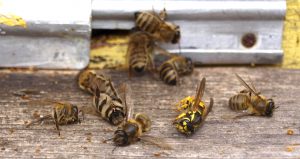
For this study, researchers used two separate bumblebee colonies and split each colony into three different groups. Two of the groups were then exposed to the neonicotinoid thiamethoxam by being fed a solution, while the third group of each colony served as the control and was not exposed to the pesticide. The solution contained thiamethoxam at a rate of two parts per billion, or 10ppb of the pesticide, a concentration the researchers say mimics the exposure bees would find in crop fields. According to the report, “After each visit to the buffalo-bur flowers used in the experiment, the bees in the control group learned how to buzz more pollen out of the anthers. But those in the 10ppb group did not improve at all.” This is significant because while all flowers do not require shaking by bees to release their pollen, other flowers require work on the part of bees to ensure pollen is transferred.
Penelope Whitehorn of the University of Stirling in Scotland, who led the study, explained the process in this way: “Bees produce a vibration — or buzz — to shake pollen out of these anthers like a pepper pot. The bee lands on a flower, curls her body around the anther and grips the base with her mandibles. She then rapidly contracts the flight muscles to produce the vibration, without beating her wings.” She called the findings “striking,” going on to say that “[t]he implication is the bees take less pollen back to the colonies and the colonies will be less successful, meaning there may be fewer pollinators overall,” making it the latest devastating effect of neonicotinoids on bees. The study will be submitted to a scientific journal next year.
In response to the findings, a spokesman for the agrochemical company Syngenta, which manufactures thiamethoxam, argued that exposure to thiamethoxam in the field is usually closer to 3ppb instead of 10ppb, but he made no further comments to discredit the connection between the chemical and the ability of bees to learn how to shake off pollen. This is not surprising, as neonics  have long been identified as a major culprit in bee decline by independent scientists and beekeepers, yet chemical manufacturers like Bayer and Syngenta have focused on  other issues, such as the varroa mite.
In light of the  shortcomings of federal action  to protect these beneficial organisms, it is left up to advocates and consumers to ensure that we provide safe havens for pollinators by creating pesticide-free habitat and educating others to do the same.  Take action by calling on EPA to suspend neonicotinoids now. You can also declare your garden, yard, park or other space as pesticide-free and pollinator friendly. It does not matter how large or small your pledge is, as long as you contribute to the creation of safe pollinator habitat.  Sign the pledge today! Need ideas on creating the perfect pollinator habitat? The  Bee Protective Habitat Guide  can tell you which native plants are right for your region. For more information  on what you can do, visit our  BEE Protective  page.
Source: Â The Guardian
All unattributed positions and opinions in this piece are those of Beyond Pesticides.
Posted in Agriculture, Alternatives/Organics, Chemicals, Corporations, Environmental Protection Agency (EPA), Increased Vulnerability to Diseases from Chemical Exposure, neonicotinoids, Pesticide Drift, Pesticide Residues, Pollinators, Wildlife/Endangered Sp. by: Beyond Pesticides
No Comments
13
Dec
(Beyond Pesticides, December 13, 2016) Net Loss, a new report released by the Center for Food Safety (CFS), indicates the use of neonicotinoid-coated seeds is exactly that, an economic drain for farmers that only results in the indiscriminate poisoning for non-target wildlife, such as pollinators. The report is a follow up to a 2014 report, Heavy Costs: Weighing the Value of Neonicotinoid Insecticides in Agriculture, which concluded  that neonic seeds bring greater costs than benefits to farmers. Later that year, a study published by the U.S. Environmental Protection Agency (EPA), which  looks specifically at the economic value of neonic coated soybeans, made similar determinations —insecticide seed coating provide little or no overall benefit in controlling insects or improving yield or quality.
CFS’s new report cites  numerous new studies published over the past several years that reinforce the group’s original determination on the realized benefits pesticide-coated seeds provide to farmers. Front and center in the report are preliminary results from the European Union’s suspension on the use of neonics on certain agricultural crops. The report finds that after the 2013 EU moratorium, despite cries from the agrichemical industry of rampant crop failures, yields actually increased. For maize, the EU saw a 5.7% rise, and oilseed rape (canola) witnessed a 14.4% increase in yields. Much like the hype of genetically engineered crops’ value, which a recent New York Times article showed to hold up poorly to scrutiny, it appears the agrichemical industry has again sold American farmers a bill of goods. Indeed, in every cropping system investigated by CFS, crop yields showed negative, negligible or inconsistent differences based on whether or not a crop seed was coated with neonicotinoid insecticides.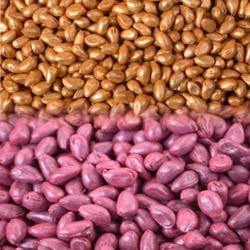
While the benefits to farmers are insignificant, the harm neonicotinoids cause to the wider environment is of serious concern. The dust kicked from planting coated seeds can drift off-field and contaminate field margins with high levels of these toxic pesticides. Indeed, the report cites findings that, depending on the crop, only five percent of the active chemical in a seed coating actually enters a crop. The other 95% of the chemical makes its way into the environment, either through seed dust, soil contamination, or water runoff. Just last month, Health Canada announced it would ban applications of the most widely used neonicotinoid, imidacloprid, as a result of dangers to aquatic life near agricultural fields. Neonics have been widely implicated as the most significant factor impacting the decline of pollinators around the globe. Effects range from acute toxicity and death, to chronic impacts such decreased memory and learning, inability for bees workers to find their way back to the hive, decreased queen fertility, and overall increased susceptibility of the colony to viruses, disease, and parasites.
Certain U.S. states are beginning to consider action to restrict the use of coated seeds. The state of Connecticut recently required the development of best management practices to avoid pesticide drift from dust kicked up during seed planting. And in Minnesota, where a recent executive order from Governor Dayton requires proof of a pest emergency before spraying foliar neonicotinoid applications, the Governor and Minnesota Department of Agriculture (MDA) also recommended legislation to give MDA the authority to regulate coated seeds. This was necessary because in the U.S., coated seeds are considered exempt articles under federal pesticide law (the federal fungicide insecticide and rodenticide act, or FIFRA).  As such, they are not subject to the same protocols and regulations governing pesticide use. A recent lawsuit from CFS challenges this loophole in pesticide law, but a decision handed down late last month affirmed the exemption, indicating that, “The Court is most sympathetic to the plight of our bee population and beekeepers. Perhaps the EPA should have done more to protect them”¦” Thus, as EPA has so far showed its unwillingness to act to help bees and beekeepers, it is up to states and local governments to push for common-sense restrictions on these toxic products. The more local governments act, the more pressure it puts on EPA and the federal government to adequately address this crisis. After over a decade of year-after-year historic declines, it is only a matter of time before the true Net Loss of this crisis is revealed.
If you’re interested in doing more to become active in your community to stop and reverse pollinator declines, see Beyond Pesticides’ Bee Protective program page. Become educated on the science, and start your advocacy efforts by contacting Beyond Pesticides at 202-543-5450 or [email protected].
Source: Center for Food Safety
All unattributed positions and opinions in this piece are those of Beyond Pesticides.
Posted in Agriculture, Chemicals, contamination, Contamination, Genetic Engineering, Minnesota, neonicotinoids, Pesticide Regulation, Pesticide Residues by: Beyond Pesticides
No Comments
12
Dec
(Beyond Pesticides,  December 12, 2016)  On November 23, Bill Bader of  Bader farms, Missouri’s largest peach farm with over 1,000 acres and 110,000 peach trees, filed a suit against the multinational, agrichemical giant Monsanto. Mr. Bader seeks compensation for extensive damags to his peach trees, which he blames on the illegal, or non-labeled, use of the toxic herbicide dicamba, brought on by sales of Monsanto’s new, genetically engineered (GE), dicamba-tolerant crops. Mr. Bader is projected to lose $1.5 million in revenue from the crop damage. The case was filed in the Circuit Court of Dunklin County, an area that has been hit especially hard by alleged illegal dicamba spraying. The farm’s insurance company refuses to cover damages from any illegal herbicide use. Without compensation for the damages, the farm risks going out of business. The illegal use of dicamba in this case is not an isolated incident. There have been many disputes in the Midwest over the  illegal spraying of dicamba and subsequent crop damage due to pesticide drift.  Numerous news reports over the past two  months in southern soybean growing regions have found that many farmers are, in response to weeds on their farms that have become resistant to glyphosate (Roundup), illegally applying dicamba-based herbicide that are not labeled for use on Monsanto’s new GE crops.
The U.S. Department of Agriculture (USDA) deregulated Monsanto’s dicamba-tolerant Roundup Ready 2 Xtendâ„¢  soybeans and Bollgard II ®XtendFlexâ„¢ cotton in January 2015. but it was not until November 2016 that the U.S. Environmental Protection Agency (EPA) registered the use of specific dicamba formulations, Xtendimaxâ„¢  and VaporGripâ„¢ for use these crops. Monsanto describes the dicamba-tolerant GE crops as “designed to provide farmers with more consistent, flexible control of weeds, especially tough-to-manage and glyphosate-resistant weeds  to maximize crop yield potential.” What was viewed by industry and EPA several years ago as a unique occurrence, weed resistance is now acknowledged to be a serious economic problem for farmers. While the agrichemical industry and its researchers can no longer ignore weed resistance  to pesticides, it continues to promote more chemical applications in GE crops as the solution, despite the success of organic systems.
Mr. Bader  claims  that dicamba, has killed more than 30,000 peach trees since 2015.  Current dicamba formulations are extremely susceptible to pesticide drift.  Dicamba is harmful even after it is deposited on target crops due to its ability to vaporize off leafy surfaces at moderate temperatures, where it is then reintroduced into the atmosphere.  A  study published by Pennsylvania State scientists  in late 2015 found dicamba drift was “frequently responsible for sublethal, off-target damage” to plants and insects. Researchers found that even very low rates of dicamba herbicide exposure negatively impacted plant flowering, and thus insect pollination.  Increased illegal dicamba use is suspected to have been on the rise since 2015, when Monsanto released their new dicamba-resistant line of crops.
Monsanto’s previous herbicide of choice, Roundup,  has faced issues with weed resistance.  Over the years, weeds and undesirable vegetation have adapted and evolved to have a  genetic resistance to Roundup  and its active ingredient  glyphosate.  This led Monsanto to reformulate their seeds to be resistant to dicamba, which still shows effectiveness against weeds.  The herbicide formulations registered by are said to be less volatile and safer than previous dicamba formulations. Since Xtend crops were registered in 2015, this left a one year gap in which farmers were provided a new seed to cultivate with, yet left without a herbicide approved for use.  Many farmers, including Bill Bader, surmise that this led to the illegal, off-label use of other volatile dicamba formulations.
“The losses will certainly be in the millions,” said Bev Randles of Randles & Splittgerber, a Kansas City law firm in a statement to St. Luois Post Dispatch.  The impact of the damages to Bader’s farm are, “more long-term and farther-reaching,” according to Randles.  With Bader Farms expected to double its financial loses by next year, they predict the farm will be out of the peach business by 2019.
The lawsuit asserts that illegal spraying could have been more limited, if not prevented, had Monsanto not released the seeds before the subsequent herbicide XtendiMax was approved for use.  “The issue here is one of ”˜foreseeability,’” said Ms. Randles. “It was entirely foreseeable that if Monsanto released the Xtend products onto the market that farmers would seek a way to protect those Xtend seeds from damage and they would do that by spraying dicamba.”
Monsanto did take steps to notify and inform farmers before the 2016 growing season that the use of dicamba was not yet approved for in-crop use, and expressed that they do not condone the illegal use of any pesticide.  Monsanto, in a recent statement, said the lawsuit, “attempts to shift responsibility away from individuals who knowingly and intentionally broke state and federal law and harmed their neighbors in the process. Responsibility for these actions belongs to those individuals alone.”
This is the first lawsuit that has been waged against Monsanto over illegal dicamba spraying, and is supported by Beyond Pesticides.  Dicamba  has been linked to damage of the kidney and liver, neurotoxicity, and developmental impacts.  While Missouri lawmakers  contemplate increasing fines  on illegal pesticide applications, ultimately, this problem will need to be addressed on a structural scale, as chemical-intensive farmers will need to diversify the crops they plant and implement other cultural practices to deter weeds, such as cover crops, crop rotation, and intercropping. Food distribution systems will also need to shift to accommodate greater diversity in farmer fields.  Organic agriculture  represents a time-tested approach to managing weeds and avoiding resistance problems that plague GE cropping systems. With organic, the use of toxic synthetic herbicides and GE seeds is prohibited, and farmers must craft an organic systems plan aimed at improving soil health and managing pests and weeds should they arise.
All unattributed positions and opinions in this piece are those of Beyond Pesticides.
Source: Â St Louis Post Dispatch
Posted in 2,4-D, Agriculture, Alternatives/Organics, Chemicals, contamination, Contamination, Corporations, Dicamba, Environmental Justice, Farmworkers, Genetic Engineering, Glyphosate, Missouri, Monsanto, Pesticide Drift, Pesticide Regulation, State/Local by: Beyond Pesticides
No Comments
09
Dec
(Beyond Pesticides, December 9, 2016) Save the Date! Beyond Pesticides is pleased to announce the 35th National Pesticide Forum, Healthy Hives, Healthy Lives, Lands: Ecological and Organic Strategies for Regeneration, which will be held April 28-29, 2017 at the University of Minnesota, Minneapolis, MN. Some of the lineup of the keynote speakers for the upcoming forum include: Liz Carlisle, author of Lentil Underground; Don Huber, PhD, professor emeritus of plant pathology and glyphosate expert, Purdue University; and Jim Riddle, organic farmer and former chair of the USDA National Organic Standards Board.
The 2017 Forum is convened by Beyond Pesticides and Organic Consumers Association. We are collaborating with local groups, such as Pollinator Friendly Alliance, Giving Tree Gardens, Humming for Bees, Kids for Saving Earth, Blue Fruit Farm, Students for Sustainability, Birchwood Cafe, Seward Community Co-op and Pesticide Action Network North America (PANNA). The Forum offers a unique opportunity during a critical time in our nation’s history to chart a course that upholds principles and values, policies and practices, that protect health and the environment. The Forum delves into key issues of the day, such as pollinator decline, a problem linked to  pesticide-intensive landscape and agricultural land management, and genetic engineered crops, whose production elevates pesticide dependency on hazardous chemicals and induces pest resistance. The Forum brings together speakers on the latest science on pesticides, from neonicotinoids to glyphosate, contrasted with practitioners utilizing organic management practices in agriculture, parks, athletic fields, and rangeland. In sum, the Forum seeks to help hone public understanding of the hazards of pesticides and the emerging science on adverse effects, while delving into local policy changes that are driving pesticide bans and incentivizing ecological and regenerative practices. The Forum includes a broad range of speakers and collaborators, and will provide an opportunity for grassroots advocates, scientists, policy makers, and land managers to discuss effective strategies and practices that work collectively for a sustainable future.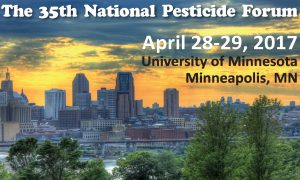
Register Today
Reserve your spot at the 2017 Forum and get the Early Bird Discount rate ($5 off). As an Early Bird buyer, you can get a general rate for $40, a student rate for $20, or a business rate for $170. Scholarships are also available. All ticket price rates include organic meals: on Friday, organic beer, wine, and hors d’oeuvre; on Saturday, organic breakfast, lunch, and dinner, plus organic beer and wine at the evening reception. For more details about registration, click here.
Featured Speakers (preliminary list)
Liz Carlisle is the author of Lentil Underground, which chronicles the sustainable agriculture movement in her home state of Montana. Carlisle is a Lecturer in the School of Earth, Energy, and Environmental Sciences at Stanford University, where she teaches courses on food and agriculture, sustainability transition, and environmental communication. Â She holds a Ph.D. in Geography from UC Berkeley and she formerly served as Legislative Correspondent for Agriculture and Natural Resources in the Office of U.S. Senator Jon Tester. Â Recognized for her academic writing with the Elsevier Atlas Award, which honors research with social impact, Liz has also published numerous pieces for general audience readers, in the New York Times, Los Angeles Times, Business Insider, and Stanford Social Innovation Review.
Don Huber, PhD Â is Professor Emeritus of Plant Pathology at Purdue University, holds B.S. and M.S. degrees from the University of Idaho, and a Ph.D. from Michigan State University. He was Cereal Pathologist at the University of Idaho for 8 years before joining the Department of Botany & Plant Pathology at Purdue University in 1971. His agricultural research over 55 years has focused on the epidemiology and control of soilborne plant pathogens with emphasis on microbial ecology, cultural and biological controls, nutrient-disease interactions, pesticide-disease interactions, physiology of host-parasite relationships and techniques for rapid microbial identification. Dr. Huber is past Chairman of the USDA-APS National Plant Disease Recovery System; a member of the US Threat Pathogens Committee; former member of the Advisory Board for the Office of Technology Assessment, U.S. Congress; and Office of the Surgeon General OTSG) Global Epidemiology Working Group. He is author or co-author of over 300 journal articles, Experiment Station Bulletins, book chapters and review articles; three books, and 84 special invited publications and an active scientific reviewer; consultant to academia, industry, and government; and international research cooperator. His work on glyphosate, raising issues of numerous health effects, enzyme function, and diminished micronutrients in plants and the food supply, put him at the cutting edge of scientific concern about the use of the world most popular herbicide.
Jim Riddle – For more than 30 years, Jim has been an organic farmer, gardener, inspector, educator, policy analyst, author and avid organic eater. He was founding chair of the Winona Farmer’s Market and the International Organic Inspectors Association, (IOIA), and co-author of the IFOAM/IOIA International Organic Inspection Manual. Jim is former chair of the USDA National Organic Standards Board and has also served on the boards of the International Organic Accreditation Service, Beyond Pesticides, and the Organic Processing Institute. He currently serves on the Citizens Board for the Minnesota Pollution Control Agency; and on the Minnesota Agricultural Water Quality Certification Advisory Committee. He is the elected Chair of the Winona County Soil and Water Conservation District Board. In addition, he and his wife own and operate Blue Fruit Farm, a diversified fruit farm in southeastern Minnesota.
Stay Tuned”¦
Check back as we add information about speakers and sessions at the upcoming conference.
If your group is interested in co-sponsoring the 35th National Pesticide Forum, please email us.
If you would like more information about the conference, please email info@beyondpesticides, or call 202-543-5450.
Videos from Last Year’s Conference
See Beyond Pesticides’ Youtube page for videos of all the speakers, panels, and workshop discussions from the 34th National Pesticide Forum! Check out BeyondPesticides’ past conferences here.
All unattributed positions and opinions in this piece are those of Beyond Pesticides.
Posted in Events, Minnesota, State/Local, Take Action by: Beyond Pesticides
No Comments
08
Dec
(Beyond Pesticides, December 8, 2016) On Monday, the Delaware Department of Agriculture (DDA) released its Managed Pollinator Protection Plan, which allows for the continuation of widespread pesticide use in landscapes across the state. The plan includes voluntary strategies for farmers, beekeepers, landowners and pesticide applicators, but fails to include any recommendations for reducing or eliminating toxic pesticide use. DDA resorts to recommending approaches that include “best management practices,” strategies to increase pollinator forage on public and private lands, and advocating for the use of Driftwatch, an online initiative that focuses on pesticide drift. Driftwatch is a voluntary effort run by the non-profit, Fieldwatch, which, according to its website, was created by Purdue University Agricultural and Biological Engineering and Agricultural Communications departments and  Purdue University Cooperative Extension Specialists  “to help pesticide applicators and specialty crop growers communicate more effectively to promote awareness and stewardship activities to help prevent and manage drift effects.”
Like other state pollinator protection plans,  there is little mention of pesticides, despite the fact that neonicotinoids (neonics) are highly toxic, persistent and systemic pesticides that have been widely implicated as a leading factor in pollinator decline. According to environmentalists and beekeepers, little meaningful action has been taken to address pesticide impacts on pollinators, and industry groups have been working  to weaken and derail pesticide reforms  at state and local levels that may protect pollinators.
Delaware’s plan follows the White House release in 2015 of the National Strategy to Promote Pollinator Health, which includes the Pollinator Research Action Plan and the Pollinator-Friendly Best Management Practices for Federal Lands. The Strategy outlines several components, such as a focus on increased pollinator habitat, public education and outreach, and further research into a range of environmental stressors, including systemic neonicotinoid pesticides. The Strategy ultimately contradicts itself by encouraging habitat, but continuing to allow pesticides that contaminate landscapes. This failure to address to one of the underlying causes of pollinator decline, systemic pesticide use, is all too common at the federal and state level.
A major component of Delaware’s plan is the creation and maintenance of habitat and forage for pollinators. It states that, “It is important to consider diversity when choosing plants to ensure adequate forage for the entire growing season.” It continues, “Diversity will also ensure pollinators have access to all of the nutrients they require to be healthy.”
Insecticide and fungicide-coated seeds are among the most popular method in chemical-intensive agriculture and landscaping of controlling target insects or fungal diseases, accounting for the vast majority of seeds for major crops and ornamental plants in the U.S. However, coated seeds result in the poisoning of nectar, pollen, and guttation droplets and indiscriminate poisoning of pollinating and foraging organisms. The sourcing of seeds uncoated with toxic pesticides and the plants needed for pollinator nutrition is absent from DDA’s plan, a problem that is shared by the other state plans.
Without restrictions on the use of neonics, pollinator habitat and forage areas are at risk for pesticide contamination and provide no real safe-haven for bees and other pollinators.
Beyond Pesticides encourages state and federal agencies to adopt organic management practices that are inherently protective of pollinators. Additionally, Beyond Pesticides and its allies have called for suspensions on neonicotinoid pesticides, particularly the most widely used and toxic: imidacloprid, clothianidin and thiamethoxam. These pesticides are used most commonly in corn and soybean seed treatment, where they remain in plant tissues, including pollen and nectar, for long periods of time.
The Delaware Pollinator Plan promotes the importance of pollinators and the impact their dwindling numbers will have on U.S. agriculture. Delaware growers produce many crops which require insect pollination, including watermelons, cucumbers, strawberries, cantaloupes, apples, blueberries, cranberries, squash, and pumpkins. According to the Pollinator Protection Plan, the production of watermelons and cucumbers “requires between 2500-3000 bee colonies to be brought into the state to maximize pollination of these crops. In addition to the colonies brought in for production, Delaware has approximately 173 registered beekeepers who manage 1500 resident hives.”
However, unless systematic pesticide contamination is addressed in state and federal pollinator plans, bees, both wild and managed, and other pollinator species will continue to be adversely affected. As noted in the text of the Delaware Managed Pollinator Protection Plan, the plan is a working document and DDA plans to “periodically update this document to reflect current working conditions and regulatory requirements.”
In the absence of federal action, some states are limiting the use of toxic, systemic neonic pesticides. In August 2016, Minnesota Governor Mark Dayton issued an Executive Order aimed at reversing pollinator decline in the state by limiting the use of toxic, systemic neonicotinoid (neonics) pesticides. Minnesota’s state-level actions are in large part due to a groundswell of local advocacy that has succeeded in protecting pollinators. Sixteen localities in Minnesota, including its  largest city Minneapolis  and its  capital St. Paul, have passed resolutions restricting the use of neonics by its local government.  It is crucial that Delaware and other states follow the lead of Minnesota and move to properly protect pollinators.
In light of the shortcomings of state and federal agencies  to protect these vital organisms, it is left up to advocates to ensure that we provide safe havens for pollinators by creating pesticide-free habitat and educating others to do the same. You can declare your garden, yard, park or other space as pesticide-free and pollinator friendly. It does not matter how large or small your pledge is, as long as you contribute to the creation of safe pollinator habitat.  Sign the pledge today! Need ideas on creating the perfect pollinator habitat? The  Bee Protective Habitat Guide  can tell you which native plants are right for your region. For more information on what you can do, visit our  BEE Protective  page.
Sources: Newsworks, Delaware.gov
All unattributed positions and opinions in this piece are those of Beyond Pesticides.
Posted in Announcements, Chemicals, Clothianidin, Contamination, Deleware, Imidacloprid, Increased Vulnerability to Diseases from Chemical Exposure, Pesticide Drift, Pesticide Regulation, Pollinators, State/Local, Take Action, Thiamethoxam by: Beyond Pesticides
No Comments
07
Dec
(Beyond Pesticides, December 7, 2016) Â Two national non-profit advocacy groups, Beyond Pesticides and Organic Consumers Association (OCA), today launched the Map of Local Pesticide Reform Policies, a resource for communities and activists that documents pesticide policies adopted by local communities to protect people, pollinators and the environment. The map spotlights over 115 communities in 21 states that have taken local action to protect their communities from the adverse effects of pesticides by substituting a range of alternative tactics, from eliminating highly toxic chemicals to the adoption of organic practices. Beyond Pesticides are inviting people across the country to sign a national petition in support of the transition to organic land management.
“The Map of Local Pesticide Reform Policies, a continuously updated resource, reflects the wave of change occurring nationwide as local and state policymakers take steps to provide protections to people and the environment that are not provided by federal policy,” said Drew Toher, public education associate for Beyond Pesticides. “The policies adopted so far reveal a strong desire by local governments to advance practices that promote nontoxic alternatives to the toxic weed- and pest-management practices increasingly seen as destructive to the health of humans and their environment.”
 “Meaningful change often starts at the local level, when concerned citizens, consumers and grassroots organizations join with elected officials and policymakers to protect health and the environment,” said Patrick Kerrigan, OCA’s retail coordinator. “This new tool will allow consumers, activists and policymakers to replicate or adapt policies that have already been successfully implemented in other communities. This will move policymaking forward faster and more efficiently, across the entire country.”
“Meaningful change often starts at the local level, when concerned citizens, consumers and grassroots organizations join with elected officials and policymakers to protect health and the environment,” said Patrick Kerrigan, OCA’s retail coordinator. “This new tool will allow consumers, activists and policymakers to replicate or adapt policies that have already been successfully implemented in other communities. This will move policymaking forward faster and more efficiently, across the entire country.”
The Map of Local Pesticide Reform Policies provides the public and local leaders with the names and locations of localities that have passed policies, the type of policy passed, a short description of the scope of the policy, and a link to view the entire text. The policy types covered in this map do not include those relating to the use of pesticides for mosquito control, in schools or in agriculture. This type of policy will be addressed in future updates to the project.
The current edition of the map includes 18 communities with pesticide-free parks programs, 29 with restrictions to protect pollinators, 66 communities with policies that restrict pesticide use on all publicly owned property, and 24 that extend restrictions to private land. (Only seven states do not preempt (prohibit) local jurisdictions from restricting pesticide use on private land).
Beyond Pesticides encourages people to review the accuracy of the information on the map, and email to [email protected] with policies that have not been captured on the map. Citizens interested in initiating a pesticide policy in their own community can sign up here for more information.
Of the 30 most commonly used pesticides, 16 are possible and/or known carcinogens, Â 17 have the potential to disrupt the endocrine (hormonal) system, 21 are linked to reproductive effects and sexual dysfunction, 12 have been linked to birth defects, 14 are neurotoxic, 25 can cause kidney or liver damage, and 26 are sensitizers and/or irritants. Children are especially sensitive to pesticide exposure, as they take in more pesticides relative to their body weight than adults and have developing organ systems that are more vulnerable and less able to detoxify toxic chemicals. Pollinator populations are experiencing catastrophic declines linked to the use of a class of systemic pesticides called neonicotinoids, which are taken up by plants and expressed in their pollen, nectar and dew droplets.
If you want to get active in your community to stop unnecessary toxic pesticide use, sign this petition and we’ll send you a blueprint for local change!
About Beyond Pesticides Â
Beyond Pesticides is a 501(c)3 nonprofit organization headquartered in Washington, D.C., which works with allies in protecting public health and the environment to lead the transition to a world free of toxic pesticides through a program of science, policy and action. For more information, please visit  www.beyondpesticides.org.
About the Organic Consumers Association
The Organic Consumers Association is an online and grassroots non-profit 501(c)3 public-interest organization advocating on behalf of more than two million consumers for health, justice, and sustainability. For more information, please visit  www.organicconsumers.org.
All unattributed positions and opinions in this piece are those of Beyond Pesticides.
Posted in Alternatives/Organics, Announcements, Children/Schools, contamination, Environmental Justice, Habitat Protection, Lawns/Landscapes, Pesticide Regulation, State/Local, Take Action by: Beyond Pesticides
1 Comment
06
Dec
(Beyond Pesticides, December 6, 2016) A new study released by researchers at the University of Washington, Seattle finds that exposure to organophosphate insecticides is associated with changes in oral bacterial diversity, particularly for exposed farmworkers. The study provides insight into the far-reaching changes pesticide exposure can cause to the human body, which are not captured by current risk assessment models used by the U.S. Environmental Protection Agency (EPA). Although past research has investigated the impact of pesticide exposure on the gut microbiome, this is one of the first studies to look at oral bacterial diversity.
For the study, scientists took oral swabs from 65 adult farmworkers and 52 non-farmworker adults in the Yakima Valley of Washington State. Swabs were taken both during the spring/summer, when exposure to pesticides is high, as well as winter, when lower exposure is expected. At the same time the swabs were taken, researchers also took blood samples of individuals in the study. Scientists focused on exposure to the organophosphate insecticide Azinphos-methyl (AZM), which at the time of the study (2005-2006) had not begun its cancellation proceedings.
Results show that farmworkers have greater concentrations of AZM in their blood than non-farmworking adults in the area. It follows that farmworkers also show greater changes to their oral bacterial diversity. Of the farmworkers that have detectable levels of AZM in their blood stream, scientists found “significantly reduced abundances of seven common taxa of oral bacteria, including Streptococcus, one of the most common normal microbiota in the mouth,” said Ian B. Stanaway, PhD candidate in Environmental Toxicology at the University of Washington in a press release. Researchers found that while reductions in bacterial diversity start in the heavy pesticide use season of spring/summer, they remain low into the winter. “Persistence from the spring/summer to the winter of this association also suggests long lasting effects on the commensal microbiota have occurred,” the study finds.
Now that researchers have discovered this association, as principal investigator Elaine Faustman, PhD, notes, “[t]he challenge becomes, what does this mean. We don’t know — we depend on the microbiome for so many metabolic processes. PhD candidate Stanaway notes, “in other studies, different species and strains of Streptococcus have been associated with changes in oral health.”
The impact of pesticides on the human microbiome is an area of growing research. In Beyond Pesticides’ recent issue of Pesticides and You, the book 10% Human was reviewed, highlighting the fact that only 10% of human cells are genetically human, and 90% microbial in origin. Reviewer Terry Shistar, PhD, writes, “Disturbing the microbiota can contribute to a  whole host of  ”˜21st century diseases,’ including  diabetes, obesity, food allergies, heart   disease, antibiotic-resistant infections, cancer, asthma, autism, irritable bowel syndrome, multiple sclerosis, rheumatoid arthritis, celiac disease, inflammatory bowel disease, and more.”
Previous research on rats has found the widely used organophosphate insecticide chlorpyrifos caused significant disruptions in the microbiome. When exposed to chronic, low doses of the chemical, certain microbial populations flourish, while others decreas. A scientific review of glyphosate by a team of fourteen renown scientists finds that the action of glyphosate as an antibiotic could alter gut diversity, “which could favor the proliferation of pathogenic microbes in humans, farm animals, pets and other exposed vertebrates,” the authors state.
While AZM use stopped in 2013, there is still significant concern over the ability of a range of pesticides to alter the human microbiome. In addition to glyphosate, researchers have recently found that several other common herbicides have been linked to antibiotic resistance. It is critical that  more research is conducted to understand the link between environmental exposure to pesticides and other toxicants, changes in the human microbiome, and the onset of disease.
Farmworkers, as usual, are on the front line of these impacts. Despite a recent important update to Worker Protection Standards, as this study shows, there is a need to drastically limit farmwoker exposure not only to organophosphates, but a wide range of toxic pesticides. Advocates are urging EPA to incorporate changes to the human microbiome into pesticide risk assessments to ensure worker safety. And when a pesticide is shown to alter levels of pathogenic, neutral, and beneficial bacteria, they maintain it should be removed from the market in favor of sustainable and organic practices that can replace these toxic chemicals.
For more information on the impact of pesticides to farmworkers and their families, see Beyond Pesticides’ Agricultural Justice webpage. And for more information on why organic practices is the right solution to address microbiome-shifting pesticides and antibiotic resistance, see Beyond Pesticides organic agriculture program page.
Source: American Society for Microbiology (press release)
All unattributed positions and opinions in this piece are those of Beyond Pesticides.
Posted in Antibacterial, Azinphos-methyl, Biomonitoring, Chemicals, Chlorpyrifos, contamination, Disease/Health Effects, Environmental Justice, Farmworkers, Pesticide Drift, State/Local, Washington by: Beyond Pesticides
No Comments
05
Dec
(Beyond Pesticides, December 5, 2016) People across the country can support farmworker children and rural communities by speaking up in support of better protection of California school children from pesticide exposure by December 9, 2016. Send a  short email to the California Department of Pesticide Regulation (DPR) ([email protected]) to tell the Department it  must expand proposed buffers around schools to one-mile to protect school children during and after school hours, and expand the rule to cover all schools and daycare centers. Given that, according to the California Department of Food and Agriculture’s latest statistics, “Over a third of the country’s vegetables and two-thirds of the country’s fruits and nuts [and a large share of dairy and livestock] are grown in California,” everyone who eats food in the U.S. has a stake in protecting children who live in the communities where the food is grown. Food purchasing decisions have a direct impact on the people who work on farms, their children, and the communities where they live.
Support the more than 75 parents, teachers and advocates for social and environmental justice who marched in Tulare County to DPR’s draft rules for pesticides use near schools last week. Led by members of the Tulare County Coalition Advocating for Pesticide Safety (TCCAPS), the protesters say that the regulations fall short in protecting school children and staff from pesticides that drift from nearby agricultural spraying. DPR’s public hearing on its draft regulation followed shortly after the march. About 60 people voiced their concerns at the meeting that lasted  three-and-a-half hours.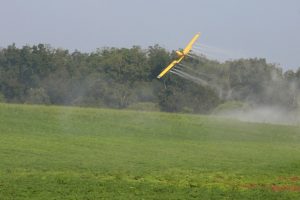
DPR’s proposed  rules will establish the first ever statewide buffer zone around public schools and daycare centers in California, prohibiting pesticide applications within a ¼ mile of schools and childcare centers.  Those that protested the new regulation say that it doesn’t go far enough to protect public health.  The regulation would only apply between the hours of 6am-6pm Monday through Friday. Parents and teachers want to extend the buffer zone to one  mile. It has been studied that pesticide drift can travel even greater than a mile away from its original application site. In fact, pesticide particles can attach themselves to air masses and be deposited across the globe.  Agricultural pesticide exposure is linked to serious childhood health concerns, including asthma, autism, cancer and developmental and neurological damages.
According to a study conducted by state and federal health departments, a one-mile buffer would prevent 85% of acute exposure illnesses. Â The study cites that 24% of non-work drift illnesses occurred at distances of ÂĽ mile or less. A University of California, Davis MIND Institute study documents significantly increased rates of autism in children of mothers who live up to one mile from pesticide-treated fields. Â The UC Berkeley CHAMACOS study of farmworker families in Salinas, CA finds contamination from the neurotoxic insecticide chlorpyrifos in homes even beyond a mile from treated fields. In addition, the California Childhood Leukemia Study reports elevated concentrations of several pesticides in the dust of homes up to Âľ mile from treated fields.
“These regulations are long overdue but they don’t go far enough,” said Fidelia Morales, a TCCAPS member and caretaker for five school-aged children. “It’s DPR’s responsibility to protect all Californians regardless of race or place, and it’s disappointing that they have proposed rules that don’t protect the community and our schools. As always, it’s low-income people of color who are vulnerable.”
In 2014, the California Department of Health released a report,  Agricultural Pesticide Use Near Public Schools,  that for the first time documented the use of the most hazardous agricultural pesticides near public schools in 15 of California’s agricultural counties. The report shed light on the use of more than a half a million pounds of 144 different chemicals that could be a cause for health concerns used within a quarter mile of public schools.  Tulare County had the highest percentage of schools with pesticides of public health concern applied within ÂĽ mile —63%, or 123 of Tulare County’s 194 public schools. Racial disparities were also identified. According to the report, ” In the 15 counties assessed, Hispanic children were 46% more likely than White children to attend schools with any use of pesticides within ÂĽ mile, compared to children attending schools with no pesticide use within ÂĽ mile.” Even more striking, the report finds that, “This difference was more pronounced with increased pesticide use, as Hispanic children were 91% more likely than White children to attend a school in the top quartile of pesticide usage, when compared to children attending schools with no pesticide use nearby.”
Under the proposed rules, pesticide applications could be applied in the early hours of the morning, an already common practice. Opponents of DPR’s new rules argue that stronger restrictions, without loopholes and allowances that allow toxic pesticide use to continue, are necessary to protect children and staff that use school grounds after hours or on weekends.
“Pesticides hang around long after they are applied and the damage from this can be long-term, as well,” said Caty Wagner, a TC CAPS member and founder of Sequoia Mavericks. “Brain-harming organophosphates are applied in enormous quantities near Tulare County schools””amounts linked to IQ loss in children for prenatal exposure,” Ms. Wagner added, referring to a recent UC Berkeley CHAMACOS study in the Salinas Valley.
“Part-time, quarter mile buffer zones are not nearly enough,” said Margaret Reeves, PhD, senior scientist with Pesticide Action Network North America. “Policymakers need to provide support and training for farmers to transition to safer farming methods that don’t harm kids. We urge state officials, particularly DPR, the Department of Food and Agriculture and the Governor to make the necessary investments in the future of California agriculture.”
Beyond Pesticides does not believe that the quarter-mile buffer zone is rigorous enough to protect public health from pesticide drift. Other deficiencies  in the proposed  regulation include  the rule’s limited scope in only addressing  public schools, leaving out private K-12 schools and private day care facilities. You can submit a comment at [email protected]  by December 9, 2016. You can see  more background from DPF  for the proposed regulations. The comment period has been extended to December 9, 2016 from its original November date.
For an in-depth look at  the dangers of pesticide drift, see  fact sheet on pesticide drift. Also, as a food consumer, the best way to protect farmworkers, their children, and rural communities from pesticide use and exposure is to buy  organic food in the grocery store. Beyond Pesticides’ Eating with a Conscience  identifies the range of pesticides used in chemical-intensive food production that is eliminated from use in organic production. To learn more about the campaign for social justice food labeling and the Agricultural Justice Project (AJP), see Social Justice Food Labeling: From food to table. For more information, see Beyond Pesticides’ Agricultural Justice webpage.
farmSource: Civil Eats & Valley Voice
Posted in Agriculture, Alternatives/Organics, Announcements, California, Chemicals, Children/Schools, contamination, Environmental Justice, Farmworkers, Pesticide Drift, Pesticide Regulation, Pesticide Residues, State/Local, Take Action by: Beyond Pesticides
No Comments
02
Dec
(Beyond Pesticides, December 2, 2016) Last week, the Arkansas Plant Board voted 12-0 to push measures that would ban or limit the use of certain forms of the toxic herbicide dicamba in the state. The hearing was called to address proposals that the board released for public comment on September 30, such as banning certain formulations of dicamba outright, creating restrictions on the time of year that other formulations of the herbicide can be used, and creating buffer zones in certain situations. This decision comes on the heels of a newly registered formulation of dicamba by the Environmental Protection Agency (EPA), and widespread reports of crop damage across the Midwest and Southeast due to the illegal use of dicamba before it was registered.
According to DTN Progressive Farmer, the three-hour public meeting was packed with almost 200 people, and approximately 20 of those testified. The testimonies highlighted the disputes and tensions that have arisen over the use of dicamba, as many remembered and spoke about Mike Wallace, a farmer who was tragically murdered on October 27 during an argument with a fellow farmer in Missouri over the illegal use of the chemical and subsequent crop damage. “We’ve seen exactly what the old formulations are capable of, and there’s not enough research to prove the new formulations will not 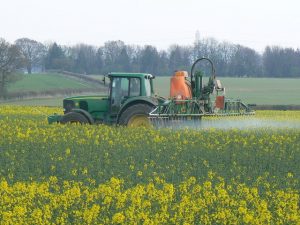 do the same,” stated Bradley Wallace, son of the late Mike Wallace. Another Arkansas farmer testified that he could visually identify 600 acres of soybeans that had been damaged by dicamba drift, estimating a $70,000 loss of income. Others testified that farmers were beginning to plant Xtend soybeans, which are genetically engineered (GE) to withstand dicamba applications, as a defensive move, as they were worried drift from neighboring farmers would hurt their crops and income. The Plant Board received 245 written comments during the public comment period, with 192 writers expressing support for the restrictions proposed, and 33 requesting a ban of all dicamba products. Only five comments expressed opposition to the proposed restrictions. During the hearing, there was also widespread support to increase the fine associated with illegal spraying, but that would require additional legislation.
do the same,” stated Bradley Wallace, son of the late Mike Wallace. Another Arkansas farmer testified that he could visually identify 600 acres of soybeans that had been damaged by dicamba drift, estimating a $70,000 loss of income. Others testified that farmers were beginning to plant Xtend soybeans, which are genetically engineered (GE) to withstand dicamba applications, as a defensive move, as they were worried drift from neighboring farmers would hurt their crops and income. The Plant Board received 245 written comments during the public comment period, with 192 writers expressing support for the restrictions proposed, and 33 requesting a ban of all dicamba products. Only five comments expressed opposition to the proposed restrictions. During the hearing, there was also widespread support to increase the fine associated with illegal spraying, but that would require additional legislation.
In October, EPA launched a criminal investigation at several locations in Missouri into the illegal spraying allegations, based on complaints about damage across Missouri and several nearby states. The complaints allege damage to more than 41,000 acres of soybeans, and other crops including peaches, tomatoes, watermelons, cantaloupe, rice, purple-hull peas, peanuts, cotton and alfalfa, as well as to residential gardens, trees and shrubs.
Pesticide drift is an inevitable problem of pesticide application, and dicamba drift and subsequent crop injury to broadleaf crops has been a frequent problem. Abnormal leaf growth, floral development, reduced yield, and reduced quality have all been observed from dicamba drift.  A  study published by Pennsylvania State scientists  in late 2015 found dicamba drift was “frequently responsible for sublethal, off-target damage” to plants and insects. Researchers find that even very low rates of dicamba herbicide exposure negatively affected plant flowering, and thus insect pollination. Dicamba has also been linked to damage of the kidney and liver, neurotoxicity, and developmental impacts. Historically, to mitigate against potential risks from pesticide drift, EPA has required buffer zones and application restrictions. However, these have not been sufficient to alleviate off-site crop damage and environmental contamination. Additionally, as demonstrated with these incidents, there are challenges with pesticide product label compliance.
The use of other highly volatile herbicides like 2,4-D on GE crops also presents growing pesticide drift concerns in light of  2,4-D tolerant GE varieties. Formulations of 2,4-D have been marketed as a “solution” for the control of glyphosate-resistant weeds brought on by the widespread use of the chemical on glyphosate-tolerant (Roundup Ready) crops over the last decade. These super weeds now infest tens of millions of acres of U.S. farmland. 2,4-D is linked to non-Hodgkins Lymphoma (NHL), and is also neurotoxic, genotoxic, and an endocrine disruptor. Both of these herbicides, when associated with GE crops, are formulated with glyphosate, which the International Agency for Research on Cancer (IARC) has identified as probably carcinogenic to humans based upon laboratory animal studies.
While the Arkansas Plant Board’s decision is a step in the right direction, there is still more work to be done. The proposals now go to the Arkansas governor for considerations, and will eventually be brought before a legislative committee for a final decision, said Terry Walker, director of the Arkansas State Plant Board, in a statement to DTN Progressive Farmer. Ultimately, this problem will need to be addressed on a structural scale, as chemical-intensive farmers will need to diversify the crops they plant and implement other cultural practices to deter weeds, such as cover crops, crop rotation, and intercropping. Food distribution systems will also need to shift to accommodate greater diversity in farmer fields. Organic agriculture represents a time-tested approach to managing weeds and avoiding resistance problems that plague GE cropping systems. With organic, the use of toxic synthetic herbicides and GE seeds is prohibited, and farmers must craft an organic system plan aimed at improving soil health and managing pests and weeds should they arise.
Source: DTN Progressive Farmer
All unattributed positions and opinions in this piece are those of Beyond Pesticides.
Posted in 2,4-D, Agriculture, Arkansas, Chemicals, Dicamba, Pesticide Drift, Resistance, State/Local by: Beyond Pesticides
No Comments

























 itely exposed one or more people (cases) to pesticides.” The number of cases associated with non-agricultural pesticide use also increased, up 16% from 2013 for a total of 798 cases. Of those 798 cases, 34% of them were defined as occupational, meaning that they occurred while the affected people were at work. PISP also looked in injuries to agricultural field workers, finding that 148 workers were affected by pesticide exposure in 25 different episodes, with 40 being the largest number of workers injured at one time.
itely exposed one or more people (cases) to pesticides.” The number of cases associated with non-agricultural pesticide use also increased, up 16% from 2013 for a total of 798 cases. Of those 798 cases, 34% of them were defined as occupational, meaning that they occurred while the affected people were at work. PISP also looked in injuries to agricultural field workers, finding that 148 workers were affected by pesticide exposure in 25 different episodes, with 40 being the largest number of workers injured at one time. s. As veteran reporter Cary Gillam notes in
s. As veteran reporter Cary Gillam notes in 









 do the same,” stated Bradley Wallace, son of the late Mike Wallace. Another Arkansas farmer testified that he could visually identify 600 acres of soybeans that had been damaged by dicamba drift, estimating a $70,000 loss of income. Others testified that farmers were beginning to plant Xtend soybeans, which are genetically engineered (GE) to withstand dicamba applications, as a defensive move, as they were worried drift from neighboring farmers would hurt their crops and income. The Plant Board received 245 written comments during the public comment period, with 192 writers expressing support for the restrictions proposed, and 33 requesting a ban of all dicamba products. Only five comments expressed opposition to the proposed restrictions. During the hearing, there was also widespread support to increase the fine associated with illegal spraying, but that would require additional legislation.
do the same,” stated Bradley Wallace, son of the late Mike Wallace. Another Arkansas farmer testified that he could visually identify 600 acres of soybeans that had been damaged by dicamba drift, estimating a $70,000 loss of income. Others testified that farmers were beginning to plant Xtend soybeans, which are genetically engineered (GE) to withstand dicamba applications, as a defensive move, as they were worried drift from neighboring farmers would hurt their crops and income. The Plant Board received 245 written comments during the public comment period, with 192 writers expressing support for the restrictions proposed, and 33 requesting a ban of all dicamba products. Only five comments expressed opposition to the proposed restrictions. During the hearing, there was also widespread support to increase the fine associated with illegal spraying, but that would require additional legislation.
